Category: Iowa history

It’s Time to Be 20 Again: Take a Road Trip on Historic Highway 20
It’s a quest that’s decades in the making. When hundreds of people gathered in Holstein on October 19, 2018, for a ribbon-cutting celebrating the completion of U.S. Highway 20 as a four-lane thoroughfare across Iowa, the focus on the future was intertwined with the history of this remarkable road–which offers the perfect route for a road trip.
“Highway 20 is the longest highway in America, spanning 3,365 miles from Boston, Massachusetts, to Newport, Oregon,” said Bryan Farr, founder and president of non-profit Historic US Route 20 Association, which promotes travel along the original 1926 alignment of US Route 20. “Modern travelers aren’t always aware of Highway 20. We want to make it a tourist destination like Route 66.”
Highway 20 passes through 12 states, including Massachusetts, New York, Pennsylvania, Ohio, Indiana, Illinois, Iowa, Nebraska, Wyoming, Montana, Idaho and Oregon. “A lot of interesting things have happened along the highway, from Puritan New England to the Wild West,” said Farr, who shared stories of history, presidents, natural wonders, quirky roadside attractions and more connected to Highway 20 during his program “Historic U.S. Route 20: A Journey Across America’s Longest Highway” on Oct. 14 to a large crowd at the Sioux City Lewis & Clark Interpretive Center.
But first things first—is 20 a highway or a route?
“It depends on where you’re from,” said Farr, who grew up in the Finger Lakes region of New York state and now lives in Chester, Massachusetts. “If you’re from Massachusetts, New York or Pennsylvania, you pronounce it ‘Root’ 20. If you’re from Ohio, Indiana or Illinois you say, ‘Route 20.’ If you’re west of the Mississippi River, it’s Highway 20.”
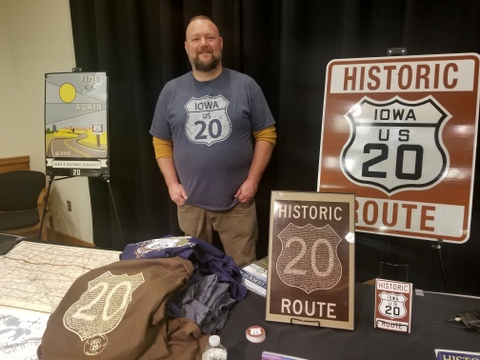
Bryan Farr is the founder and president of non-profit Historic US Route 20 Association, which promotes travel along the original 1926 alignment of US Route 20.
History happened here
The remarkable history of Highway 20 started with the passing of the Federal Highway Act of 1921, which appropriated $75 million for road construction throughout the country. The roads that would become Highway 20 were officially designated during the summer of 1925, with the original alignment of the highway taking shape in 1926.
Creating the modern, efficient, paved, four-lane highway travelers enjoy across Iowa today, however, took decades to create, Farr said. The road was often re-aligned throughout its history, and much of it was gravel for part of the highway’s history. “There are still little sections of the 1926 alignment of Highway 20 outside of Early and Fort Dodge that still are gravel,” Farr noted.
Speaking of Fort Dodge, this Highway 20 city has an unforgettable connection to Cardiff, New York, another Highway 20 town where one of the greatest hoaxes of the nineteenth century took place.
It all started when Stubb Newell of Cardiff, New York, needed a new well. On Oct. 16, 1869, Newell directed two well diggers to a spot he selected behind his barn. The men dug 3 feet and hit something solid. They uncovered a huge stone foot. As they dug more, an entire body of a man emerged. Two days later, a large tent was placed over the 10-foot stone man and crowds of nearly 200 to 500 people a day paid 50 cents to see this giant. Scientists, philosophers and the clergy attended and were challenged in their beliefs, noted the Historic US Route 20 Association website.
Legendary showman P.T. Barnum offered $60,000 for the giant but was turned down. Soon, however, the hoax came to light when people recalled a man named George Hull (a cousin of Newell) had visited a gypsum mine at Fort Dodge in 1868. He commissioned a 5-ton block to be used to carve a statue of Abraham Lincoln. The block of gypsum was shipped to Chicago and carved into this giant man. The carving’s surface was treated with acids and picked at with needles to give it an antiquated look. It was then shipped and buried in New York.
Today, the giant rests at the Farmers’ Museum in Cooperstown, New York. In 1969, a replica was created from the same gypsum quarry and is on display at the Fort Museum in Fort Dodge.
These types of stories offer a unique perspective of Highway 20, which Farr has traveled from coast to coast. “I want to bring people back into small town America, to shop locally and support local businesses to boost economic development in communities that may be bypassed by interstate highways or other more popular routes.”
Gaining a new perspective of Highway 20
Highway 20 is also distinguished by a number of other noteworthy distinctions, including:
• Ties to some of America’s major and mid-sized cities. Highway 20 includes Boston, Buffalo, Cleveland, Chicago and Boise.
• A connection to five presidents. “Highway 20 is a presidential route,” said Farr, citing George Washington as well as Abraham Lincoln, whose famous debates with political rival Stephen Douglas took place in Freeport, Illinois. Highway 20 is also connected Galena, Illinois, where President Ulysses S. Grant had a home. In northern Ohio, Highway 20 passes through Freemont, home of President Rutherford B. Hayes, who served from 1877 to 1881, oversaw the end of Reconstruction and attempted to reconcile the divisions left from the Civil War. Cleveland, Ohio, honors President James Garfield, who was elected president in 1881 but whose service was cut short after 200 days in office when he was assassinated and later died on September 19, 1881.
• The women’s movement organized along the future Highway 20. The Seneca Falls Convention was the first women’s rights convention in the United States. Held in July 1848 in Seneca Falls, New York, the meeting launched the women’s suffrage movement, which more than seven decades later ensured women the right to vote.
• Highway 20 name is more than just name. In 1925, a system of numbered highways debuted in America to replace the jumbled, confusing mess of named auto trails. “Routes with a zero at the end, like Route 20, were transcontinental routes,” said Farr, author of the book “Historic Route 20: A Journey Across America’s Longest Highway.” “Also, east-west routes have even numbers, while north-south routes have odd numbers.”
• Iowa attractions abound along Highway 20. Spanning roughly 330 miles across Iowa from Dubuque to Sioux City, Highway 20 offers plenty to see and do, Farr said. A few options include Dyersville, home of the famous Field of Dreams movie site, the National Farm Toy Museum and the Basilica of St. Francis Xavier; Independence, home of the Heartland Acres Agribition Center, which connects visitors to the past, present and future of Iowa agriculture; Sac County, with its famous barn quilt trail and world’s largest popcorn ball in Sac City and Sioux City, with its rich history related to the journey of the Lewis and Clark expedition nearly 250 years ago.
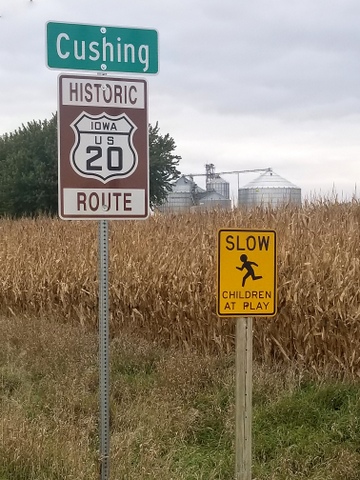
While the first Historic Route 20 sign was placed in Painesville, Ohio, in 2014, Cushing became the first Iowa community to display one of the distinctive signs. This sign greets visitors as they enter the small Woodbury County town from the east on the old route of Highway 20.
It’s interesting to note that bypasses started being built along Highway 20 almost from the start, starting in Massachusetts in the late 1920s. By the 1950s, bypasses in Iowa rerouted Highway 20 out of Farley in eastern Iowa. The trend hasn’t stopped since then. In recent years, communities along historic Highway 20 have been installing signs to denote their unique place along the route. While the first Historic Route 20 sign was placed in Painesville, Ohio, in 2014, Cushing became the first Iowa community to display one of the distinctive signs. This sign greets visitors as they enter the small Woodbury County town from the east on the old route of Highway 20.
While efficient transportation has its place, Farr encourages travelers venture off the interstates and four-lane Highway 20, explore the nearby towns and rural areas and see some the best of America. “Highway 20 is like a companion,” said Farr, who is promoting the new slogan “It’s time to be 20 again.” “This road will take you home.”
Want more?
Thanks for stopping by. I invite you to read more of my blog posts if you value intriguing Iowa stories and history, along with Iowa food, agriculture updates, recipes and tips to make you a better communicator.
If you like what you see and want to be notified when I post new stories, be sure to click on the “subscribe to blog updates/newsletter” button at the top of this page, or click here. Feel free to share this with friends and colleagues who might be interested, too.
Also, if you or someone you know could use my writing services (I’m not only Iowa’s storyteller, but a professionally-trained journalist with 20 years of experience), let’s talk. I work with businesses and organizations within Iowa and across the country to unleash the power of great storytelling to define their brand and connect with their audience through clear, compelling blog posts, articles, news releases, feature stories, newsletter articles, social media, video scripts, and photography. Learn more at www.darcymaulsby.com, or e-mail me at yettergirl@yahoo.com.
If you’re hungry for more stories of Iowa history, check out my top-selling “Culinary History of Iowa: Sweet Corn, Pork Tenderloins, Maid-Rites and More” book from The History Press. Also take a look at my latest book, “Dallas County,” and my Calhoun County” book from Arcadia Publishing. Both are filled with vintage photos and compelling stories that showcase he history of small-town and rural Iowa. Order your signed copies today! Iowa postcards are available in my online store, too.
Let’s stay in touch. I’m at darcy@darcymaulsby.com, and yettergirl@yahoo.com.
Talk to you soon!
Darcy
@Copyright 2018 Darcy Maulsby & Co. Blog posts may only be reprinted with permission from Darcy Maulsby.
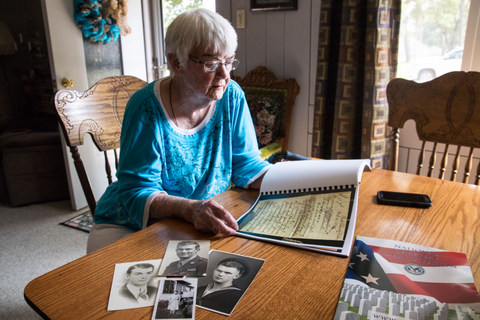
DNA Helps Sailor Killed at Pearl Harbor Return to His Family
It was the telegram no family wanted to receive. “The Navy Department deeply regrets to inform you that your son Bernard Vincent Doyle, seaman second class, U.S. Navy, is missing following action in the performance of his duty and in service of his country.”
The telegram, dated December 20, 1941, was sent to Doyle’s father, John. Weeks later it was confirmed that Bernard “Barney” Doyle, a 19-year-old from Red Cloud, Nebraska, had been killed in action while serving on the battleship USS Oklahoma during the Japanese attack on Pearl Harbor on December 7, 1941.
The loss still lingers. “My brother was the most caring person I knew,” said Fran Nutter, 94, Doyle’s younger sister who has lived in Lake City since 1947. “He was always happy, and everyone liked him.”
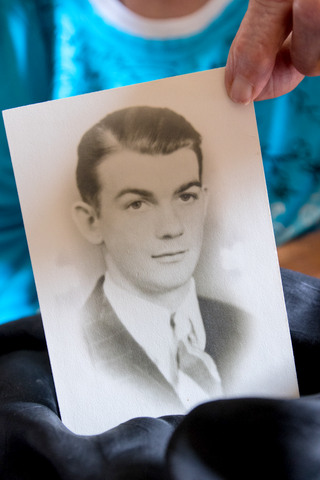
Bernard Doyle, sailor, USS Oklahoma, killed in action at Pearl Harbor
Doyle was buried with full military honors at the Lake City Cemetery around noon on October 13, 2018, following a Mass of the Christian burial at St. Mary’s Catholic Church in Lake City at 11 a.m. High-ranking members of the U.S. Navy attended the services, which were open to the public.
While Doyle’s remains had been classified as non-recoverable, a new chapter in his story is being written, thanks to advances in DNA technology that allowed his remains to be identified and returned to his family. Gov. Kim Reynolds ordered that all flags in Iowa fly at half-staff from sunrise to sunset on October 13 to honor Doyle.
All this support is comforting to Nutter and her family. “I always kept Bernard’s picture on display in my home,” she said. “My family thinks he’s a hero.”
Service and sacrifice
Bernard Doyle was born in Esbon, Kansas, on January 17, 1922, and grew up on a farm with his six brothers and sisters. The family lived in south-central Nebraska, not far from where their grandfather John Doyle homesteaded in Kansas, said Nutter, who remembers the hardships of the Great Depression. “Those were the days when Dad put molasses on tumbleweeds for the cattle to eat.”
After graduating from Red Cloud High School in 1940, Bernard Doyle enlisted in the U.S. Navy on May 28, 1940, in Omaha. He was later assigned to the USS Oklahoma, which was part of the U.S. Pacific Fleet.
The USS Oklahoma arrived in Pearl Harbor on December 6, 1940, one year and one day before to the fateful attack. The USS Oklahoma was on Battleship Row on the morning of December 7, 1941, when Japanese forces attacked Pearl Harbor. The Japanese used dive–bombers, fighter–bombers and torpedo planes to sink nine ships, including five battleships.
The crew of the USS Oklahoma did everything they could to fight back, according to the official website of the USS Oklahoma. In the first 10 minutes of the battle, though, eight torpedoes hit the USS Oklahoma, and she began to capsize. A ninth torpedo hit her as she sunk in the mud.
More than 2,400 Americans died during the Pearl Harbor attacks, including 429 men on the USS Oklahoma. In the aftermath of the tragedy, however, families back home didn’t know if their loved ones had survived or perished.
“After I heard the news, I had a feeling my brother would be okay,” said Nutter, who was working at an ammunition depot in Denver, Colorado, at the time. “I had no idea how serious things really were.”
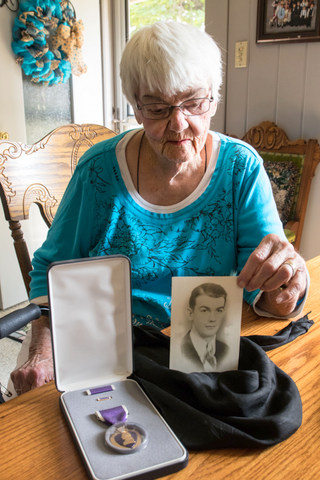
Fran Nutter displays her older brother Bernard’s picture and his Purple Heart.
In the weeks following the Pearl Harbor attack, the remains of men lost aboard the USS Oklahoma were recovered, and 35 were identified. Doyle was not among them, though. “For two months, my parents had no word about my brother’s fate,” said Nutter, who has a note her parents wrote to the Navy on February 10, 1942.
John and Mary Ellen Doyle’s pain is clear in the letter, which reads, “Others from Red Cloud, Nebr., whose sons were there have heard concerning them. We ask you to please give the matter your immediate attention.”
“You can almost sense the desperation in my mother’s letter,” Nutter said.
By Feb. 13, 1942, Rear Admiral Randall Jacobs notified the Doyle family that “after an exhaustive search, it has been found impossible to locate your son…and he has therefore been officially declared to have lost his life in the service of his country as of Dec. 7, 1941.”
Doyle and hundreds of other “unknowns” were buried at the National Memorial Cemetery of the Pacific located at Punchbowl Crater in Honolulu, Hawaii. “My mother accepted that this was God’s way of taking my brother,” Nutter said. “I never thought Bernard would be found, and I wondered what he went through in his last moments.”
All four of Nutter’s brothers, including Johnnie, Bernard, Eugene and Robert, served in various branches of the military during World War 2, including the Army, Navy and Marines. Of the four, only Bernard Doyle never returned.
“I know for a fact that Bernard’s death inspired my brother Eugene to enlist,” said Nutter, who added that Eugene Doyle was a 17-year-old high school student at the time and needed his parents’ consent.
“I thank God”
Memories of Bernard Doyle, who was awarded the Purple Heart, never faded among his family. When Nutter and her late husband, Dean, traveled to Hawaii for their 45th wedding anniversary in the late 1980s, they visited the Punchbowl and saw Bernard Doyle’s name on a memorial. “I didn’t know his name was there, and I started to cry,” Nutter said.
By 2003, the U.S. military started trying to identify individual remains of U.S. service members killed at Pearl Harbor. The process was difficult, however, since DNA technology was not as advanced as it is today. Also, remains of deceased service members were sometimes mixed together. In some cases, the partial remains of more than 100 service members were placed together in one casket.
As DNA technology advanced, the military renewed efforts to identify those killed at Pearl Harbor. In 2015, all remaining caskets at the Punchbowl that were associated with the USS Oklahoma were exhumed. The remains were transferred to laboratories in Hawaii and Offutt Air Force Base in Nebraska.
In 2015, a representative from the military called Nutter to update her and send her a DNA kit. Nutter and various family members, including her daughter Deanne Grantham of Lake City, didn’t hesitate to provide DNA samples. “I thought, ‘Good, we’re on the right track,’” Nutter said.
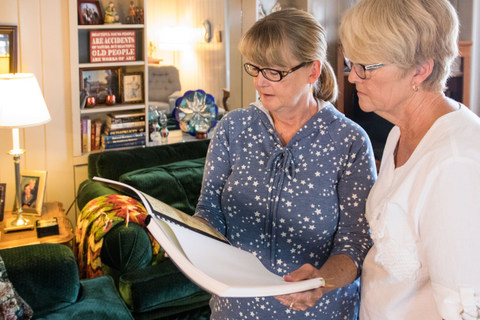
Deanne Grantham (left) and her sister Pat Albright of Lake City, Iowa, review information supplied about their uncle from the U.S. Navy.
Doyle was positively identified by dental remains and an incomplete skeleton in very good condition, said Chief DeShannon Beaty with the U.S. Navy, who visited Nutter and her family in Lake City in August 2018 to share the findings. “It’s interesting and humbling to be part of this,” said Beaty, who noted that some families like the Nutters embrace this history, while others show little interest in the identification of their ancestor’s remains.
Nutter wonders if Doyle might have become a teacher had he lived. “He was so patient,” she said.
In 2017, the family purchased a headstone for Bernard Doyle. Now he’ll be honored properly during the October 13 ceremony, said Nutter, who has gained a new appreciation for the U.S. military after going through this experience. “I thank God so many times for everyone who helped identify my brother so we could bring him home.”
Darcy’s note: It was an honor to share this story of the Nutter family and Bernard Doyle, since the family members are close friends of mine. This article originally ran in the Fort Dodge Messenger. Thank you to all our servicemen and women who protect America.
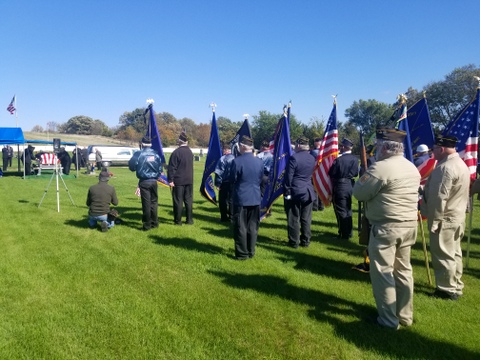
The funeral for sailor Bernard Doyle, killed at Pearl Harbor, was held Oct. 13, 2018, in Lake City, Iowa, with full military honors.
Want more?
Thanks for stopping by. I invite you to read more of my blog posts if you value intriguing Iowa stories and history, along with Iowa food, agriculture updates, recipes and tips to make you a better communicator.
If you like what you see and want to be notified when I post new stories, be sure to click on the “subscribe to blog updates/newsletter” button at the top of this page, or click here. Feel free to share this with friends and colleagues who might be interested, too.
Also, if you or someone you know could use my writing services (I’m not only Iowa’s storyteller, but a professionally-trained journalist with 20 years of experience), let’s talk. I work with businesses and organizations within Iowa and across the country to unleash the power of great storytelling to define their brand and connect with their audience through clear, compelling blog posts, articles, news releases, feature stories, newsletter articles, social media, video scripts, and photography. Learn more at www.darcymaulsby.com, or e-mail me at yettergirl@yahoo.com.
If you’re hungry for more stories of Iowa history, check out my top-selling “Culinary History of Iowa: Sweet Corn, Pork Tenderloins, Maid-Rites and More” book from The History Press. Also take a look at my latest book, “Dallas County,” and my Calhoun County” book from Arcadia Publishing. Both are filled with vintage photos and compelling stories that showcase he history of small-town and rural Iowa. Order your signed copies today! Iowa postcards are available in my online store, too.
Let’s stay in touch. I’m at darcy@darcymaulsby.com, and yettergirl@yahoo.com.
Talk to you soon!
Darcy
@Copyright 2018 Darcy Maulsby & Co. Blog posts may only be reprinted with permission from Darcy Maulsby.
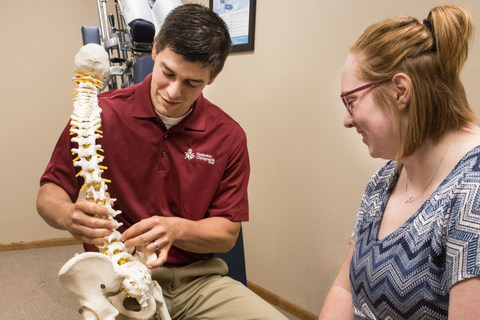
Young Entrepreneur Grows a Healthy Business in Small-Town Iowa
It’s no secret that rural Iowa has suffered through decades of population loss. The current trends are sobering, when you see data from the U.S. Census Bureau showing that two-thirds of Iowa counties (that’s 71 counties, including my home county of Calhoun County in west-central Iowa) lost population between 2010 and 2017, while 28 saw gains. So what would attract a young entrepreneur to an area like Calhoun County?
It’s a question I asked Dr. Jeff Redenius, who opened Redenius Chiropractic, PLC, in my hometown of Lake City (population 1,700) in 2016. Not only has this native son grown his customer base at his thriving chiropractic clinic, which is housed in the former variety store on Main Street, but perhaps the biggest surprise of all is the popularity of his attached 24-hour fitness center. So what’s the secret of this dynamic entrepreneur’s success? Here’s his story, which I shared in the 2018 Hometown Pride section of the Fort Dodge Messenger.
Back to Health:
Dr. Jeff Redenius Promotes Fitness, Wellness for All Ages
Jeff Redenius had enough to worry about as final exams loomed during his senior year at Central College in Pella. As he studied for his tests, however, the Lake City native suddenly felt like a knife was plunging into his chest.
“It was so intense I couldn’t take a deep breath,” said Redenius, 28, who owns Redenius Chiropractic, PLC, and a 24-hour fitness center in Lake City. “I went to a chiropractor and found out I had a rib out of place.”
A quick adjustment provided effective relief. Redenius learned that displaced ribs are fairly common and can be triggered by stress. “I typically see at least one patient each day with a displaced rib,” said Redenius, who opened his chiropractic clinic along Main Street in Lake City in August 2016.
Redenius’s own ordeal with pain prompted him to pursue a career in chiropractic care. “I was amazed at how much relief I experienced by going to the chiropractor,” he said. “I had known since high school that I wanted to go into health care, but this experience helped me clarify which area of health care to specialize in.”
Becoming a business owner
Redenius first discovered the value of high-quality health care close to home when he tore the anterior cruciate ligament (ACL) in his knee while playing football during his junior year of high school.
“I went to the hospital for physical therapy and began to appreciate all the medical care we have right here in Lake City,” said Redenius, who graduated from Southern Cal High School in Lake City in 2008.
After earning his bachelor of science degree in athletic training from Central College in in 2012, he wasn’t sure whether he wanted to pursue an advanced degree in physical therapy or chiropractic care. His displaced rib during final exams, along with his desire to own his own business, prompted his decision to enroll at the Palmer College of Chiropractic in Davenport.
“My dad, Gary, is a carpenter and has run his business for years, and I wanted to follow in his footsteps,” added Redenius, who had often worked with his father on construction projects through the years.

During Redenius’s years at Palmer, he served as the head athletic trainer and worked with the Palmer men’s and women’s rugby teams. After graduating from Palmer in February 2016, he and his wife, Jenny, a Hudson, Iowa, native, assessed their options about their next career moves.
The couple considered moving to Waverly, since it’s a growing community and a college town, but it proved more affordable for Redenius to open his chiropractic clinic in his hometown, especially when the local dime store on Main Street came up for sale.
“I knew a lot of people around here, which I figured would help grow my business faster,” Redenius said. “We also like the affordable cost of living and the chance to be close to family and raise our son, Sam, here.”
Fitness center proves popular
With approximately 5,500 square feet in the former dime store, the spacious building offered room for more than just a chiropractic clinic with exam rooms, a therapy room and an x-ray room. When Jenny suggested adding a fitness center, Redenius didn’t think it was feasible. “It was a great idea, but I was so overwhelmed by opening the chiropractic clinic that I didn’t think I could take on another project.”
Then Redenius found out that the Palmer College of Chiropractic was building a new fitness center and was willing to sell all the equipment from the former fitness center, including the free weights, the cable machines and the elliptical trainers, for a great deal. He rounded up some strong helpers, lined up a semi-truck and moved all the gym equipment to his building in Lake City.
After some remodeling, Redenius’s new 24-hour fitness center was ready for business. “We opened the fitness center in June 2016, a few months before I opened my chiropractic clinic in August that year,” Redenius said.
Some fitness center members like to take exercise classes and work with a personal trainer, while others like Mary Fern like to design their own workout routine. “I come here five to six days a week,” said Fern, 91, who moved to Lake City in August 2017. “It’s convenient, plus I like the variety.”
Fern walks laps in the gym, uses the cable machine to strengthen her arms and works out on the NuStep, which looks similar to an exercise bike and offers a safe, low-impact way to get a total-body workout. “Why do I exercise? If you don’t use it, you lose it,” she said.
Fern is a walking example of the power of healthy living, said Redenius, who features a quote from Thomas Edison on the wall of his reception area. “The doctor of the future will give no medication but will interest his patients in the care of the human frame, diet and in the cause and prevention of disease.”
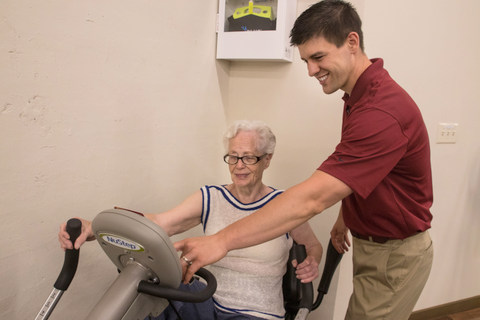
Dr. Jeff Redenius promotes fitness for all ages. Mary Fern is 91 years young and follows a “use it or lose it” exercise and wellness philosophy.
“We’ve only started to make our mark”
While fitness and chiropractic care go hand in hand, along with massage therapy services provided at Redenius Chiropractic by therapist Haley Abbott, Redenius doesn’t hesitate to refer patients to other health-care providers, when necessary.
Redenius is also seeking new ways to promote healthy living, including a new weight-loss program he began offering this summer. The four-stage program includes a meal plan and weekly coaching to help patients reach a healthier weight. “You only have one body, and I’m more about preventing disease than fixing problems.”
That spirit of service also extends to Redenius’s hobbies and work in the community. In 2017, he purchased the Baptist Church complex in Lake City after the congregation joined with the Woodlawn Christian Church in Lake City. He has been remodeling the education wing into two apartments. One unit has been rented, and the other is available for rent.
“I like to build things and create positive change, from people’s health to my business to the local community,” Redenius said. “We’ve only started to make our mark.”
Want more?
Thanks for stopping by. I invite you to read more of my blog posts if you value intriguing Iowa stories and history, along with Iowa food, agriculture updates, recipes and tips to make you a better communicator.
If you like what you see and want to be notified when I post new stories, be sure to click on the “subscribe to blog updates/newsletter” button at the top of this page, or click here. Feel free to share this with friends and colleagues who might be interested, too.
Also, if you or someone you know could use my writing services (I’m not only Iowa’s storyteller, but a professionally-trained journalist with 20 years of experience), let’s talk. I work with businesses and organizations within Iowa and across the country to unleash the power of great storytelling to define their brand and connect with their audience through clear, compelling blog posts, articles, news releases, feature stories, newsletter articles, social media, video scripts, and photography. Learn more at www.darcymaulsby.com, or e-mail me at yettergirl@yahoo.com.
If you’re hungry for more stories of Iowa history, check out my top-selling “Culinary History of Iowa: Sweet Corn, Pork Tenderloins, Maid-Rites and More” book from The History Press. Also take a look at my latest book, “Dallas County,” and my Calhoun County” book from Arcadia Publishing. Both are filled with vintage photos and compelling stories that showcase he history of small-town and rural Iowa. Order your signed copies today! Iowa postcards are available in my online store, too.
Let’s stay in touch. I’m at darcy@darcymaulsby.com, and yettergirl@yahoo.com.
Talk to you soon!
Darcy
@Copyright 2018 Darcy Maulsby & Co. Blog posts may only be reprinted with permission from Darcy Maulsby.
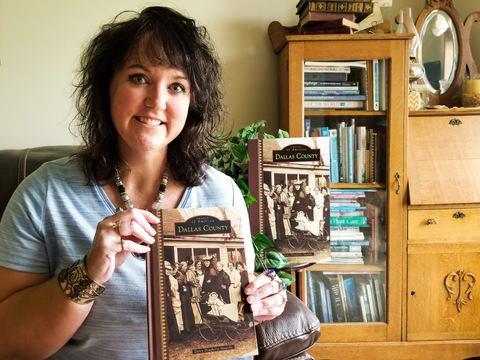
The Hotel Pattee and I are Hosting a Party—And You’re Invited!
What are you doing on Monday evening, Sept. 11? I would like to personally invite you to Perry to the historic Hotel Pattee at 7 p.m. for the debut of Dallas County, my latest non-fiction Iowa history book. It’s all here—drama, crime (Bonnie and Clyde), politics (Dallas County made President Harry Truman the original Comeback Kid), romance, tragedy, mystery, action, adventure, sports, food, agriculture, architecture, science, business, biography, comics and more—all told through more than 100 vintage photos and short stories in 10 chapters.
During this fun event at the hotel (click here for all the details!), I’ll take you on a time-traveling virtual tour of fun, surprising and sometimes shocking Dallas County history highlights. Stick around for the book signing after the program, and then stroll through the iconic Hotel Pattee to tour some of the guest rooms that will be open that evening. Every room in this grand boutique hotel features unique décor that tells the stories of Perry, Dallas County and Iowa history.
I’ve specifically asked that the luxurious Louis Armstrong Suite be open that evening. (In case you’re wondering about the Iowa connection, Louis Armstrong performed in Dallas County in 1954 at the legendary Lake Robbins Ballroom near Woodward and stayed at the Hotel Pattee.)
If nothing else, stop by on Sept. 11 for the homemade cookies the Hotel Pattee’s culinary team is preparing with some of my favorite recipes!
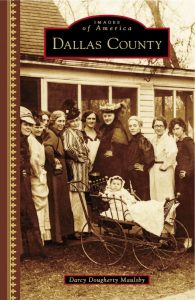 Explore forgotten Iowa history
Explore forgotten Iowa history
I am so excited to bring you this new hardcover, illustrated book, which is the first in-depth, non-fiction history of Dallas County, Iowa, in nearly 80 years!
No Iowa county has influenced American history more than Dallas County. It propelled Harry Truman to an unlikely victory in the 1948 presidential campaign, following a fiery speech he delivered to 100,000 farmers on a sweltering September day at the National Plowing Match near Dexter. Just 15 years earlier, a shoot-out near Dexfield Park marked the beginning of the end for infamous outlaws Bonnie and Clyde and the notorious Barrow Gang.
Dallas County, located just west of Des Moines, has produced several major-league baseball players (among them Bob Feller and Hal Manders), a US congressman (David Young), and Nile Kinnick, the 1939 Heisman Trophy winner and University of Iowa football legend whose grandfather George Clarke, of Adel, served as Iowa’s governor from 1913 to 1917.
Today, Dallas County is one of the fastest-growing counties in America and remains a region of opportunity with a rich heritage of small-town living, farming, coal mining, and the immigrant experience.
My 128-page book from Arcadia Publishing (order signed copies here) is filled with intriguing black-and-white, vintage photos on nearly every page, along with stories from Adel, Perry, Waukee, Granger, Woodward, Dexter, Linden, Minburn, Dawson, Dallas Center, Van Meter, Redfield, Bouton, surrounding rural areas and ghost towns.
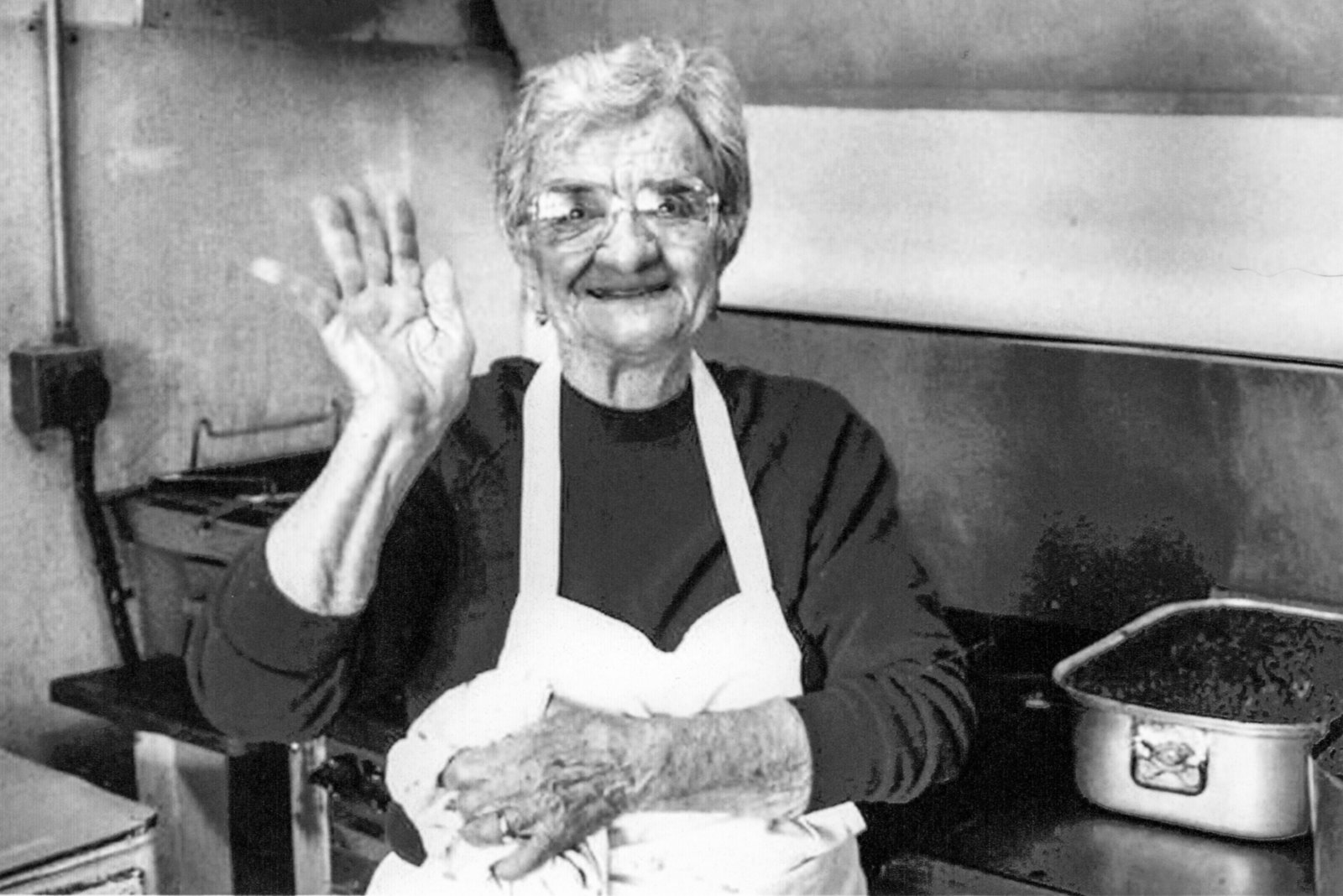
Alice Nizzi, owner of Alice’s Spaghettiland, an Italian restaurant open from 1947 – 2004 in Waukee. Source: Waukee Area Historical Society
Here’s a quick list of highlights that make this Dallas County book unique:
1. Many of the images have been donated from private collections.
2. In the early 20th century, Dallas County was one of the biggest coal-mining areas of Iowa. Much of this history, from Waukee to Woodward, is shared in this new Dallas County book. You can also get the inside story in this guest blog post I wrote for Hometown Heritage in Perry.
3. At least two circuses once made Dallas County their home base, including the famous Orton Bros. three-ring circus, where Five generations of the Orton family thrilled audiences for years. The Yankee Robinson Show, a Midwestern traveling circus, made its winter quarters two miles southeast of Granger. The spacious area also provided a place to bury deceased circus elephants. Granger may be the only Iowa town to claim an elephant graveyard.
4. Minburn’s legendary Singing Wheels roller skating show debuted in 1950 and ran through the early 1960s. Local children, high school students from the Minburn Roller Club and adults all participated in the Singing Wheels’ summer performances, which included a new theme every year, eye-catching costumes, and choreographed routines. These shows attracted thousands of people to the Minburn roller skating rink.
5. The Lake Robbins Ballroom, which opened on November 11, 1931, near Woodward, is still a popular entertainment destination and is one of the few remaining ballrooms in Iowa. The legendary Louis Armstrong performed at Lake Robbins in 1954 and stayed at the Hotel Pattee in Perry, where the most luxurious suite in the hotel is named in his honor.
6. Granger became the focal point of a successful New Deal program inspired by Monsignor Luigi Ligutti, who had served Assumption Church in Granger since 1926. Ligutti felt coal camps were an unsuitable environment for children and looked to the land to address the miners’ economic and social challenges. The 225-acre Granger Homesteads, built in 1935, included 50 modern homes, along with approximately four acres each for raising crops and livestock. In 1936, First Lady Eleanor Roosevelt visited the Granger Homesteads and praised the success of the project.
7. The KKK was active in Dallas County, especially Perry, in the early 1920s. Almost 15,000 people witnessed a KKK parade and semi-public meeting in Perry on May 31, 1924.
8. Dallas County is one of the fastest-growing counties in America and remains a region of opportunity with a rich heritage of small-town living, farming, coal mining, and the immigrant experience.
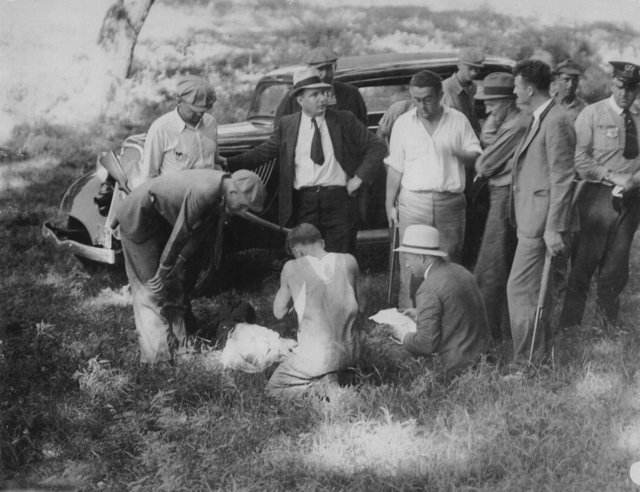
While Bonnie and Clyde escaped, Clyde’s older brother, Buck Barrow (shown lying on the ground), was mortally wounded during a shootout with law enforcement during the early morning hours of July 24, 1933, near Dexfield Park in southern Dallas County. Buck would die a few days later at Kings Daughters Hospital in Perry. Source: Dexter Museum
Click here to order your signed copy today! Priceless memories of Iowa history make a great gift, too.
• Series: Images of America
• Hardcover: 128 pages
• Publisher: Arcadia Publishing (September 4, 2017)
Want more?
Thanks for stopping by. I invite you to read more of my blog posts if you want more more intriguing Iowa stories and history, along with Iowa food, recipes and tips to make you a better communicator.
If you like what you see and want to be notified when I post new stories, be sure to click on the “subscribe to blog updates/newsletter” button at the top of this page. Feel free to share this information with friends and colleagues who might be interested, too.
If you’re hungry for more stories of Iowa history, check out my top-selling “Culinary History of Iowa: Sweet Corn, Pork Tenderloins, Maid-Rites and More” book from The History Press, as well as my Calhoun County” book from Arcadia Publishing, which showcases the history of small-town and rural Iowa. Order your signed copies today! Iowa postcards are available in my online store, too.
Let’s stay in touch. I’m at darcy@darcymaulsby.com, and yettergirl@yahoo.com.
About me:
Some people know me as Darcy Dougherty Maulsby, while others call me Yettergirl. I grew up on a Century Farm between Lake City and Yetter and am proud to call Calhoun County, Iowa, home. I’m an author, writer, marketer, business owner and entrepreneur who specializes in agriculture. Learn more at www.darcymaulsby.com.
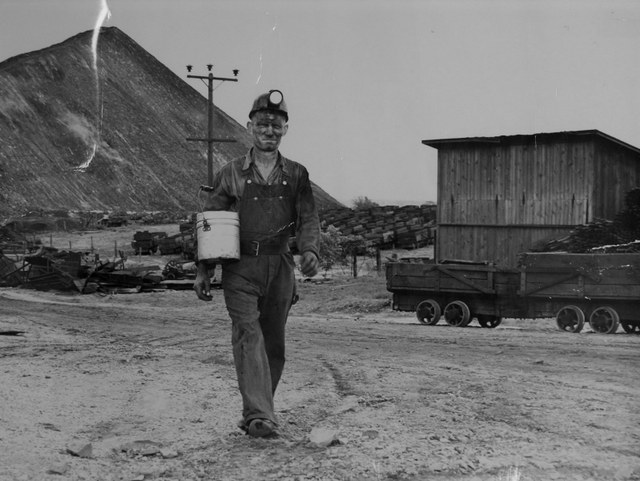
Iowa Underground – How Coal Mining Fueled Dallas County’s Growth
There was a time when Dallas County was one of the most important coal-mining counties in Iowa. While this way of life vanished decades ago, the memories live on, from rooms at the historic Hotel Pattee in Perry to the coal-mining museum in the Waukee Public Library to the many descendants of mining families who still live in the area.
From Moran to Woodward to Waukee, Dallas County thrived with the increased demand a century ago for coal to power train locomotives and heat businesses and homes. Coal was a relatively cheap, plentiful energy source. With ample supplies of coal, Dallas County became a land of opportunity for immigrant miners from Europe and beyond.
Coal mining started in the Van Meter area as early as the 1870s. By the early 1900s, coal was discovered in Des Moines Township east of Woodward, leading to the creation of the Scandia and Phildia mining settlements. After the Phildia mine was abandoned in 1915 and the Scandia mine closed in 1921, miners moved on to the Moran mine, which opened in 1917 west of Woodward.
It’s not on most maps today, but there was a time when Moran was a bit of a boom town.Another mining town–Angus–was an even bigger boom town north of Perry. The Angus & Moran Room at the Hotel Pattee in Perry recalls the history of these areas, which are now little more than ghost towns.
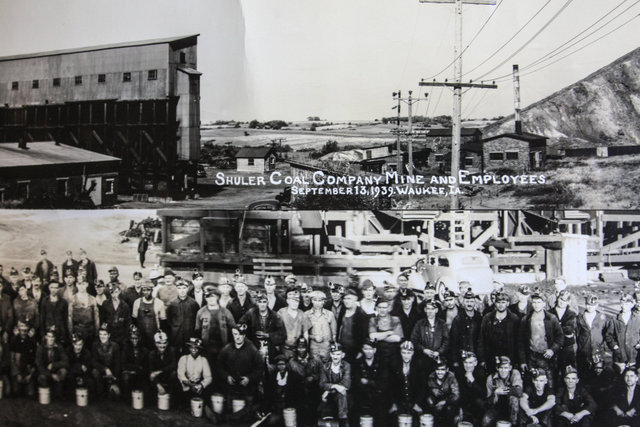
Shuler Coal Mine and employees shown here on September 13, 1939, in Waukee, Iowa. The mine was open from 1921 to 1949. Source: Waukee Area Historical Society
Living with danger
On the opposite side of Dallas County, coal mining also transformed the Waukee area in the early twentieth century. The Harris Mine opened on September 20, 1920, just two and a half miles northeast of Hickman Road in Waukee.
By 1921, the Shuler Coal Company of Davenport, Iowa opened a coal mine on Alice’s Road, one mile east of the Harris Mine. At its peak production, the mine employed more than 450 men.
The Shuler Mine became one of the largest producers of coal in Iowa, and it had one of the deepest mine shafts–387 feet deep. The mine produced coal for Iowa State University, as well as for local railroads, businesses and homes.
The miners worked in the Shuler mine with the help of more than 30 mules, bringing up hundreds of tons of coal per day and millions of tons of coal over the mine’s 28 years of operation. The miners’ work day often started at 6 a.m., and they wouldn’t return home until 4 or 4:30 p.m.
Mining was dangerous, dirty work. Miners used dynamite, as well as heavy picks, to break coal loose from the coal veins. When the siren blew, it was a sign that a miner was in trouble, or there had been a cave-in.
“I can remember the whistle blowing in succession to let people know there had been an accident,” noted Angelo Stefani, whose uncle was killed in a mining accident. “I can also vividly member women coming out of their homes to see what happened. They were hysterical.”
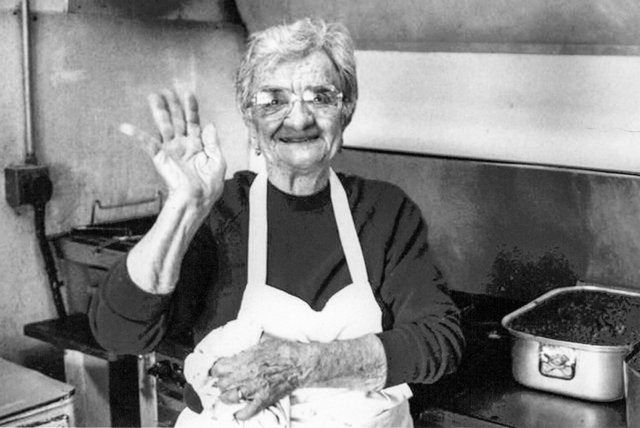
Alice Nizzi was the founder and owner of the beloved Alice’s Spaghettiland, an Italian restaurant open from 1947 – 2004 in the Waukee area. Source: Waukee Area Historical Society
Life in Waukee’s coal mining community
The Shuler mining camp was home to Italians, Croatians and people of other ethnicities. Most families lived in small, simple houses with no running water, but they often raised chickens and tended enormous gardens where they grew a variety of vegetables.
Work wasn’t always steady. Dallas County’s coal mines often closed in the summer, when demand for coal dropped off in the warmer months. Miners would often work for local farmers or do odd jobs around the community to help pay the bills.
Some of the miners’ wives, especially those in Italian families, worked at local restaurants like Rosie’s and Alice’s Spaghettiland near Waukee to supplement the family’s income. Alice Nizzi (1905–1997) opened Alice’s Spaghettiland in the Shuler mining community just north of Hickman Road in 1947. The restaurant’s waitresses were required to wear white, starched uniforms. Alice’s became a destination and Waukee-area institution for decades until it closed in 2004.
The Waukee Area Historical Society hosted a fundraising dinner in the spring of 2014 featuring Alice’s spaghetti and Italian salad. Hundreds of people now attend this fun event, which has been held each April for the past few years.
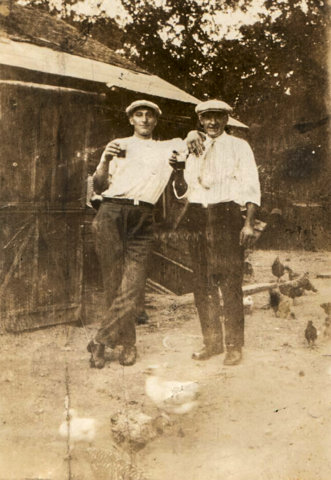
Terzo Fiori (left) and Pete Nizzi enjoyed tasting their homemade wine. Excitement spread through Waukee’s mining camps when grapes were imported from California and shipped by train in two boxcars so families could make their yearly supply of red wine.
Remembering the grape trains
For Italian families in the Shuler mining camp, one of the highlights of the year was the arrival of the annual trainload of grapes for making homemade wine.
“Excitement spread throughout the camp when the train arrived, and most of the people from the mining camp came to help unload the box cars,” said Gilbert Andreini, whose memories are recorded at the coal mining museum at the Waukee Public Library. “It was like a celebration.”
The end of an era
By the time the Shuler mine closed in 1949, Iowans began looking to energy sources other than coal for home use, such as electricity, natural gas and heating oil. In addition, the railroads were converting from steam to diesel engines, reducing the need of coal for locomotives.
While Dallas County’s coal mines have vanished into history, those who grew up in the mining camps will never forget how these areas grew into close-knit communities. Everyone knew everyone else and helped each other out, recalled Bruno Andreini.
“I’m very proud of those times. Anyone from that community is like a brother or sister to me. Even though we were poor, we had things that were far more valuable than money.”
Note from Hometown Heritage
I originally wrote this as a guest blog post for Hometown Heritage in Perry. Here’s a note from Hometown Heritage:
If you’d like to meet Darcy, hear more of her stories, and enjoy some Dallas County-inspired snacks, Darcy will be speaking at Hotel Pattee on September 11th, 2017, from 7 – 9 pm as part of Hometown Heritage’s fall programming series. For more information on this, please visit our website.
You can also learn more about Darcy on her website (www.darcymaulsby.com), and her new Dallas County book is available for pre-order on Amazon.
Want more?
Thanks for stopping by. I invite you to read more of my blog posts if you want more more intriguing Iowa stories and history, along with Iowa food, recipes and tips to make you a better communicator. If you like what you see and want to be notified when I post new stories, be sure to click on the “subscribe to blog updates/newsletter” button at the top of this page. Feel free to share this information with friends and colleagues who might be interested, too.
If you’re hungry for more stories of Iowa history, check out my top-selling “Culinary History of Iowa: Sweet Corn, Pork Tenderloins, Maid-Rites and More” book from The History Press, as well as my Calhoun County” book from Arcadia Publishing, which showcases the history of small-town and rural Iowa. Order your signed copies today! Iowa postcards are available in my online store, too.
Let’s stay in touch. I’m at darcy@darcymaulsby.com, and yettergirl@yahoo.com.
P.S. Thanks for joining me. I’m glad you’re here.
@Copyright 2017 Darcy Maulsby & Co.
About me:
Some people know me as Darcy Dougherty Maulsby, while others call me Yettergirl. I grew up on a Century Farm between Lake City and Yetter and am proud to call Calhoun County, Iowa, home. I’m an author, writer, marketer, business owner and entrepreneur who specializes in agriculture. Learn more at www.darcymaulsby.com.
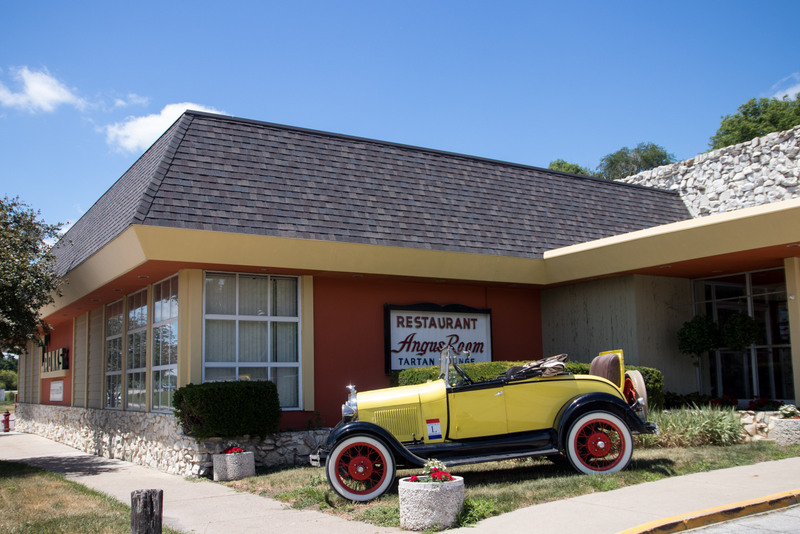
Cruising Through Forgotten Iowa History on Lincoln Highway
If you ever travel U.S. Highway 30 across Iowa, you’re never far away from the Lincoln Highway, if not right on top of it. If you’ve ever driven on Interstates 80 or 35, you’re also enjoying a legacy of fast, efficient transportation that took root with the Lincoln Highway more than 100 years ago.
I was reminded of the Lincoln Highway’s pivotal role when I shared my “Culinary History of Iowa” program with 100+ Lincoln Highway enthusiasts from New York to California who met in Denison from June 20-24 for the Lincoln Highway Association’s 2017 annual conference. As attendees shared their stories with me, it was clear the Lincoln Highway’s magic hasn’t waned through the decades.
Perhaps we should all thank the founders of the Lincoln Highway for helping get rural Iowa out of the mud. Oh, that mud!
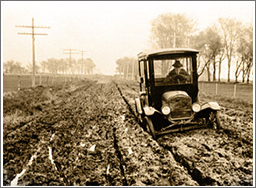
It’s obvious why Iowa needed to get out of the mud 100+ years ago.
As late as 1912, road conditions in the United States and Iowa were often deplorable, especially in rural areas. Few roads in the countryside were graded, and maintenance fell to those who lived along them.
The lack of paved roadways meant travel was always dominated by the weather. In wet weather, roads turned to mud and became impassable. During the winter months, you could be stranded on the farm for weeks if snowdrifts blocked the roads.
Iowans, like most Americans, were frustrated by poor road conditions, especially as the automobile’s popularity took off. Indiana native Carl Graham Fisher envisioned a solution. A tireless promoter of the automobile industry, Fisher had a track record of success, having joined a group of Indianapolis businessmen who invested in what became the Indianapolis Motor Speedway.
At a dinner meeting in 1912 in Indianapolis, Fisher proposed the idea of a highway that would span America from coast to coast. Stretching nearly 3,400 miles, this “rock highway” named in honor of President Abraham Lincoln would follow the shortest, fastest, most practical route. Fisher’s goal was to finish the highway by the 1915 Panama-Pacific Exposition. The highway’s path would run from New York City to the Exposition’s host city of San Francisco.
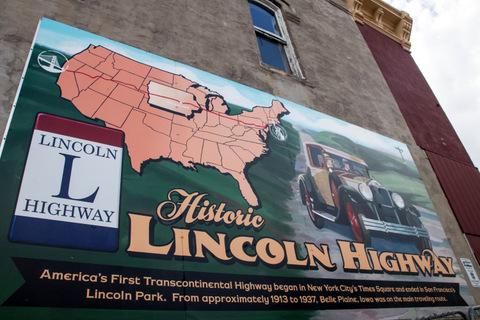
Belle Plaine, Iowa, celebrates its rich Lincoln Highway history.
Established in 1913, the Lincoln Highway transformed automobile travel from a tortuous journey to an exciting adventure. In Iowa, the Lincoln Highway was built from Clinton to Council Bluffs, connecting the Main Streets of 43 communities along the way.
As the first coast-to-coast highway, the Lincoln Highway demonstrated the power of good roads for transportation and commerce. It accelerated the Good Roads Movement, which helped get Iowa and other states out of the mud. On a national scale, the Federal Highway Administration and interstate highway system decades later marked the culmination of these efforts.
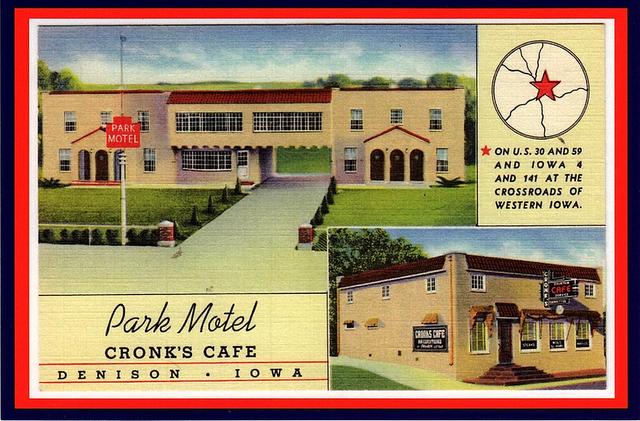
This vintage postcard shows the historic Park Motel and Cronk’s Cafe in Denison along the Lincoln Highway.
While interstates often offer the fastest way to crisscross Iowa today, I’ve been taking the backroads, including the Lincoln Highway, on some of my recent excursions around Iowa. I got a kick out of “Travel Tips from the Past” that the Iowa Lincoln Highway Association recently posted on its website and also appeared in a Washington Post article. While these road-trip gems were first promoted in the early 1900s by etiquette maven Emily Post and fellow motorists Effie Gladding and Beatrice Larned Massey, they still hold true today:
• Stop on a whim. If you see an intriguing café, go in. I recently stopped at the Lincoln Café in Belle Plaine and enjoyed a delicious bowl of vegetable beef and noodle soup, an Italian beef sandwich and coleslaw, along with a side of history. This café has served locals and travelers since 1928.
• Pause to take in the view. It usually takes me awhile to get to my destination, because I stop often to capture rural Iowa’s beauty with my camera.
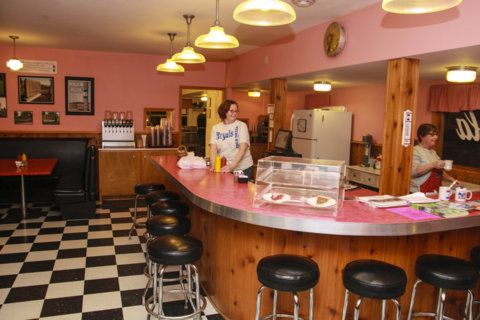
The Reed-Niland Corner in Colo has served travelers since the 1920s and is likely the only remaining spot on the entire Lincoln Highway that still features a café (try their homemade ham-and-bean soup and a slice of pie!), vintage gas station and motel.
• Eat local. I love supporting locally-owned businesses that preserve the history of the Lincoln Highway, from the Santa Maria Winery in Carroll to the fabulous Reed-Niland Corner in Colo. This Story County treasure has served travelers since the 1920s and is likely the only remaining spot on the entire Lincoln Highway that still features a café (try their homemade ham-and-bean soup and a slice of pie!), vintage gas station and motel.
No matter where your summer road trips take you in Iowa and beyond, long live the legacy of the iconic Lincoln Highway!
This story first appeared in my Farm News column in June 2017.
Want more?
Thanks for stopping by. I invite you to read more of my blog posts if you want more more intriguing Iowa stories and history, along with Iowa food, recipes and tips to make you a better communicator. If you like what you see and want to be notified when I post new stories, be sure to click on the “subscribe to blog updates/newsletter” button at the top of this page. Feel free to share this information with friends and colleagues who might be interested, too.
If you’re hungry for more stories of Iowa history, check out my top-selling “Culinary History of Iowa: Sweet Corn, Pork Tenderloins, Maid-Rites and More” book from The History Press, as well as my Calhoun County” book from Arcadia Publishing, which showcases the history of small-town and rural Iowa. Order your signed copies today! Iowa postcards are available in my online store, too.
Let’s stay in touch. I’m at darcy@darcymaulsby.com.
P.S. Thanks for joining me. I’m glad you’re here.
@Copyright 2017 Darcy Maulsby & Co.
About me:
Some people know me as Darcy Dougherty Maulsby, while others call me Yettergirl. I grew up on a Century Farm between Lake City and Yetter and am proud to call Calhoun County, Iowa, home. I’m an author, writer, marketer, business owner and entrepreneur who specializes in agriculture. Learn more at www.darcymaulsby.com.
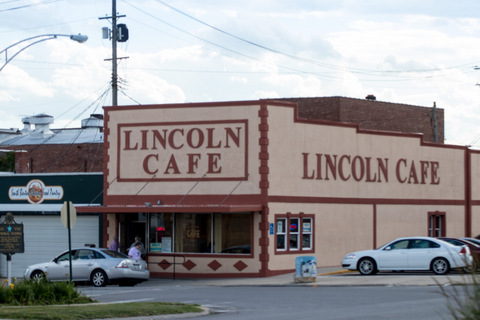
The historic Lincoln Cafe in Belle Plaine has served home-cooked food along the Lincoln Highway since 1928.
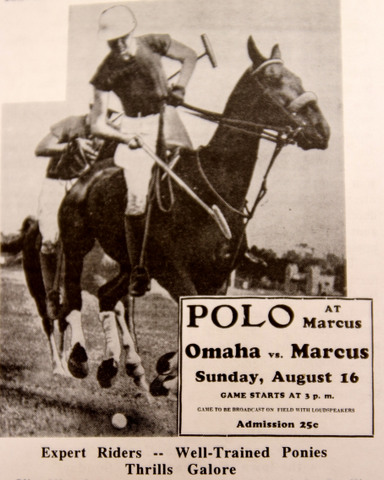
Small – Town Iowa Polo Teams Thrilled Depression – Era Crowd
What comes to mind when you think of polo? English royalty, perhaps, since this ancient, unique blending of athletic talents between horse and rider helped polo become the “sport of kings.”
Yet there was a time in northwest Iowa when polo reigned as the sport of the common people. It happened in an era when rural Iowans desperately needed a diversion, if only for a Sunday afternoon, from life’s harsh realities.
It all started in the early 1930s in the small Cherokee County town of Marcus. I first heard about this intriguing tidbit of local history from Beth Kingdon, director of the Marcus Public Library, when I shared my “Culinary History of Iowa” program at the library. “Since you like Iowa history, you might be interested in this,” said Beth, as she opened the 700+-page book “Pride in the Past Faith in the Future: A Historical View of Marcus, Iowa.”
Sure enough, right there on pages 157-158 a section titled “Marcus Polo Team” spun a long-forgotten tale of rural Iowa. “The Marcus Polo Team made history in the 1930s for the small but prosperous farm community, providing thrilling Sunday entertainment for residents far and near,” stated the article.
No doubt there were thrills galore, since there’s nothing subtle about polo. This is in-your-face, aggressive horsemanship at its best, demanding power, intense speed, balance, coordination, quick reflexes, strategy, well-trained horses and expert riders.
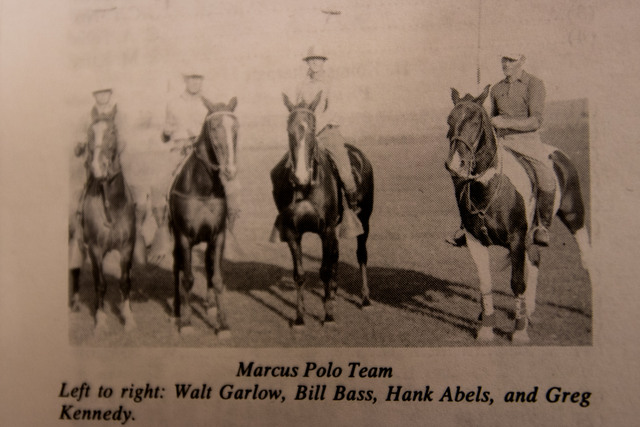 “Shucking corn develops a wrist, and that’s what polo takes”
“Shucking corn develops a wrist, and that’s what polo takes”
The Marcus team consisted of local businessmen and farmers, including Gregory Kennedy, Kenneth (Kim) Bancroft, W.W. (Bill) Bass, Henry (Hank) Abels, Walter Garlow and Glenwood French (the alternate). The Marcus Polo Club boasted a “splendid field” just a mile and a half south of town, where polo matches were played on the W.E. Wiley farm (managed by Walt Garlow). “Two Marcus youths, Jimmy Hogue and Roy (Junior) Williams, were full-time groomsmen for Kennedy and Garlow,” the history noted.
Polo was introduced in Marcus around 1931. By the early to mid-1930s, there were polo teams and/or polo fields in Paullina, Primghar, Clarion, Sheldon, Spencer and beyond, including the famous Barnes Bros. polo team from the Cherokee/Peterson area.
The Marcus Polo Club gained a strong reputation by beating professional teams from Minnesota to Omaha and clinched the Iowa championship by defeating the Des Moines team at the Iowa State Fair. The Marcus Polo Club eventually expanded into two teams, the Purple Team and the Orange Team, which traveled as far away as Sioux City and Pierre, South Dakota, to compete.
The famed Marcus team even caught the media’s attention. In 1936, Country Home magazine devoted a page-long article to document this fascinating phenomenon on the Iowa prairie. Here’s a snippet from Paul T. Sturges’ feature story:
“But polo,” I objected. “Isn’t that a millionaire’s game?
“Practically everyone seems to think so,” said Kenneth Bancroft. “But around here, most of our players are farmers.”
We were talking in Bancroft’s meat market in Marcus. On the wall, pictures of sleek polo ponies flashed white-helmeted riders, a team as proud as the best of them.
“No, don’t get the idea polo is just a rich man’s game,” continued Bancroft.
“Bill Ginger started us going. We used farm horses for mounts. Bill lives up a Gaza, Iowa. He’s farming. Had played polo in the Black Hills, enough at least to get polo in his blood.”
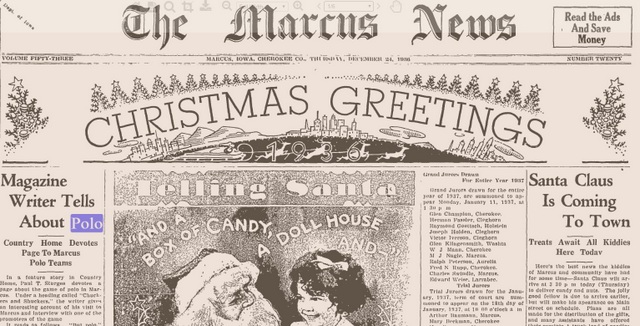 To make a polo mallet, Bill unearthed an old binder roller, sawed out a chunk, drilled a hole into it, and inserted a lengthy of hickory wood into this homemade affair. “First thing they know, people saw Bill out in his pasture on horseback larruping a ball around,” Bancroft said.
To make a polo mallet, Bill unearthed an old binder roller, sawed out a chunk, drilled a hole into it, and inserted a lengthy of hickory wood into this homemade affair. “First thing they know, people saw Bill out in his pasture on horseback larruping a ball around,” Bancroft said.
Joe Hey, the harness maker, braided whang leather loops on the mallets’ handles. A local pasture provided the playing field, and it was game on. “On stock saddles cinched to regular farm horses, the boys, when the farm work was done, would make for the pasture and have a barrel of fun. The players lined up in center field. The umpire throws the ball out, and it’s in play until it crosses the goal.”
Those Iowa farmers knew their style of polo was a bit—unique. “If today’s crack polo players could have seen us then, they would have died laughing,” Bancroft said. “Imagine horses weighing 1,800 pounds galloping after a little ball.”
The rural Iowa polo players’ gear made the game affordable, from homemade mallets to second-hand Army saddles. “It was inexpensive,” Bancroft noted. “The town boys boarded their ponies with the farmers, who, in turn, found the extra horses came in handy during cultivating time. Corn-shucking time, our players would use their horses on the wagon and then in the evenings would throw on saddles for a whirl at polo. Shucking corn develops a wrist, and that’s what polo takes.”
Chukkers and shuckers
The talented Marcus Polo Club beat professional teams from Minnesota to Omaha and clinched the Iowa championship by defeating the Des Moines team at the Iowa State Fair. The Marcus Polo Club eventually expanded into two teams, the Purple Team and the Orange Team, which traveled as far away as Sioux City and Pierre, South Dakota, to compete.
In the 1930s, just like now, each polo team consisted of four riders and their mounts. The ideal polo pony combined intelligence, speed and stamina, with the ability to accelerate, stop and turn quickly. All horse breeds were allowed to play polo, but a majority ranged from 15-16 hands tall. (A hand is equal to 4 inches.)
“Each player [with the Marcus Polo Club] has two or more ponies, and, in general, have an excellent string of horses,” noted the Marcus history book.
The story also cited Slim Nix, the “wild-riding cowboy,” captain, coach and trainer of Paullina Pirates polo team, who said “a man gives his wife credit for half she does, but a polo player gives his pony credit for 75 percent of his good playing.”
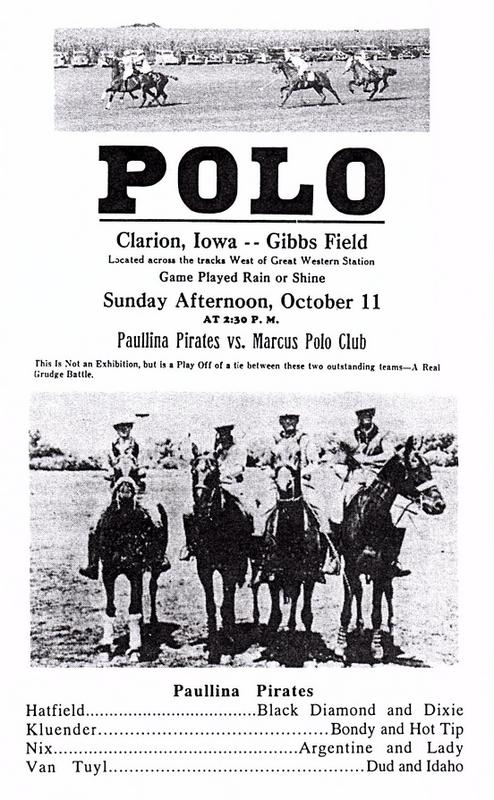 Some of the Paullina players paid big money for the best ponies and gear. Dr. G.E. Van Tuyl played a gray horse, which he purchased in Idaho for $1,000. (That’s roughly $18,000 in today’s money.)
Some of the Paullina players paid big money for the best ponies and gear. Dr. G.E. Van Tuyl played a gray horse, which he purchased in Idaho for $1,000. (That’s roughly $18,000 in today’s money.)
Horses and riders competed on an outdoor polo field measuring 300 by 160 yards. Outdoor polo games consisted of six chukkers (periods) of 7 minutes and 30 seconds each. The main objective? Defeat your opponent by scoring the highest number of goals.
What a spectacle this must have been during the Great Depression, when crowds of rural Iowans flocked to polo fields across the state. Though admission cost 25 cents to see the Marcus team play tough competitors like Omaha more than 80 years ago, the promised rewards were almost irresistible. “These horses can turn on a dime and give you 8 cents in change,” one ad proclaimed. “Everyone come and see this thrilling game.”
This column originally appeared in Farm News July 2017.
Want more?
Thanks for stopping by. I invite you to read more of my blog posts if you want more more intriguing Iowa stories and history, along with Iowa food, recipes and tips to make you a better communicator. If you like what you see and want to be notified when I post new stories, be sure to click on the “subscribe to blog updates/newsletter” button at the top of this page. Feel free to share this information with friends and colleagues who might be interested, too.
If you’re hungry for more stories of Iowa history, check out my top-selling “Culinary History of Iowa: Sweet Corn, Pork Tenderloins, Maid-Rites and More” book from The History Press, as well as my Calhoun County” book from Arcadia Publishing, which showcases the history of small-town and rural Iowa. Order your signed copies today! Iowa postcards are available in my online store, too.
P.S. Thanks for joining me. I’m glad you’re here.
@Copyright 2017 Darcy Maulsby & Co.
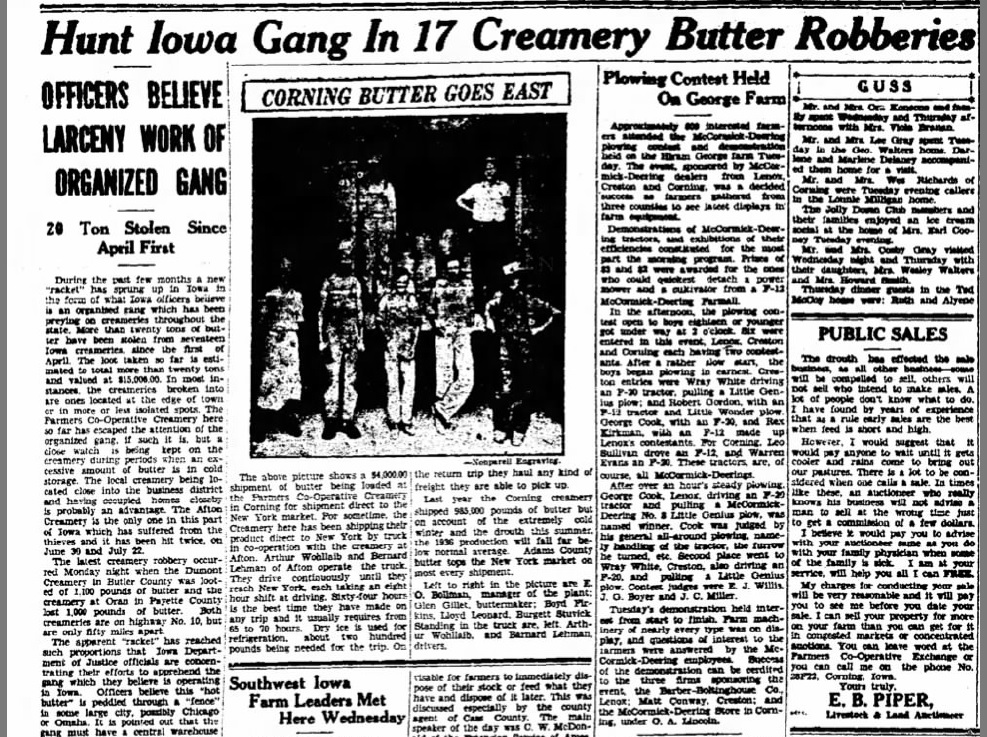
Busting the Iowa Butter Gang
“Hey, did you ever hear of the Iowa Butter Gang?” It’s the last question I expected to hear during my recent “Culinary History of Iowa” book signing in West Des Moines, and it definitely caught my attention.
It came from Jan Kaiser, a former Des Moines librarian who had first “encountered” the nefarious gang a few years ago through research into 70+-year old newspaper archives.
Turns out that crime came in many forms during the Great Depression. Back then, butter was big business in rural Iowa. Not only was Iowa a leading dairy state, but hundreds of Iowa creameries produced high-quality butter that helped make Iowa a top shipper of butter into the New York City area, I learned recently from Iowa Secretary of Agriculture Bill Northey.
While some Depression-era criminals robbed banks, some thieves in rural Iowa opted to rob creameries. A headline in the Aug. 6, 1936, edition of the Adams County Free Press newspaper announced, “Hunt for Iowa Gang in 17 Iowa Creamery Butter Robberies: Officers Believe Larceny Work of Organized Gang.”
The article noted that during the spring and summer of 1936, a new “racket” had sprung up in Iowa in the form of an organized gang that preyed on creameries throughout the state. By early August 1936, more than 20 tons of butter had been stolen from 17 Iowa creameries since early April 1936. “The loot taken so far is estimated to total more than 20 tons and is valued at $15,000,” noted the news article.
In most cases, the creameries that were broken into were located on the edge of town or in isolated spots. The gang’s targets in 1936 included:
• April 3, Palmer, 2,172 pounds
• April 8, Fenton, 3,440 pounds
• May 15, Fenton, 2,080 pounds
• May 28, Edgewood, 630 pounds
• June 4, Britt, 5,184 pounds
• June 12, Kimballton, 4,000 pounds
• June 20, Coulter, 4,095 pounds
• June 30, Afton, 2,200 pounds
• July 1, Hampton, 2,209 pounds
• July 3, Hubbard, 7,488 pounds
• July 8, Palmer, 3,553 pounds
• July 11, Randall, 2,304 pounds
• July 22, Afton, 2,764 pounds
• July 30, Nashua, 1,500 pounds
• July 31, Masonville, 2,228 pounds
• August 3, Dumont, 1,100 pounds
• August 3, Oran, 1,000 pounds
“It is believed that before each burglary, the creamery is selected by the gang and careful plans made,” stated the Adams County Free Press. “The robbers are evidently expert burglars and experience little difficulty in breaking into creameries. They use a truck and are gone with their loot before local officials know there has been a burglary.”
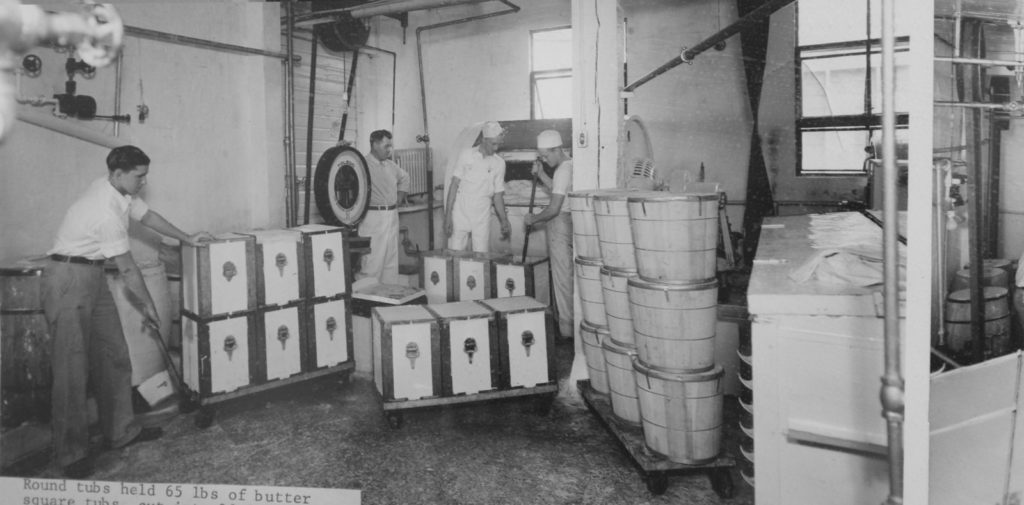
Butter making was big business in small-town creameries across Iowa in the 1930s, including this creamery in Somers (featured in my Calhoun County book). George Smith built Somers’ first creamery was built in 1900. In 1913 S. P. Petersen purchased and updated the creamery, which became a major business in town for many years. The round tubs in this photo each held 65 pounds of butter. This butter was sold to area stores. In Fort Dodge alone, about 2 tons of butter was sold each week. Butter from Somers was also sent to New York.
Peddling “hot butter”
The writer speculated that the gang must have a central warehouse, since butter is highly perishable. The apparent racket reached such epic proportions that Iowa Department of Justice officials concentrated their efforts to apprehend the gang. “Officers believe this ‘hot butter’ is peddled through a ‘fence’ in some large city, possibly Chicago or Omaha,” the writer noted.
(A fence is someone who knowingly buys stolen property for later resale, sometimes in a legitimate market. The fence acts as a middleman between thieves and the eventual buyers of stolen goods who may not be aware that the goods are stolen.)
The article continued, “The Farmers Co-operative Creamery here [in Corning] so far has escaped the attention of the organized gang, but a close watch is being kept on the creamery during periods when an excessive amount of butter is in cold storage.”
It’s no wonder locals were keeping a close watch. The Farmers Co-op Creamery shipped thousands of dollars of butter each year to the New York market. The Adams County Free Press reported that two local truck drivers would each take eight-hour driving shifts and drive straight through from Iowa to New York. The best time they made from Iowa to New York was 64 hours, although the trip usually took 65 to 70 hours.
About 200 pounds of dry ice were used for refrigeration during the trip. On the return trip, the drivers hauled any kind of freight they were able to pick up. In 1935, the Corning creamery shipped 985,000 pounds of butter, noted the newspaper article. Due to the harsh winter and summer drought of 1936, however, that year’s production was expected to fall far below average—a fact that made the butter robberies of 1936 even more devastating in rural Iowa.
Finally—a big break in the case
By August 1936, officers with the Iowa State Patrol (formed just a year earlier in 1935) and a group of northern Iowa vigilantes and deputy sheriffs had been driving the secondary and dirt roads nightly for the last two months, trying to catch the butter gang, according to the Des Moines Tribune (the capital city’s afternoon newspaper that ended in 1982).
Some promising leads ended in disappointment. In the summer of 1936, officers arrested Harvey Mighell of Holstein on suspicion that he was connected with the butter gang. He was taken to Audubon, where he was questioned and later released under $2,000 bond. Mighell denied having anything to do with the Iowa butter thefts.
Law enforcement officials got a big break, however, by late August 1936. A headline in the Aug. 29, 1936, edition of the Des Moines Tribune proclaimed “Iowa Butter Gang Crushed.”
Turns out an Omaha gang of six men and one woman stole some $30,000 worth of butter, cheese and eggs in a string of more than 30 robberies across Iowa in 1936. (The pilfered dairy products were worth nearly $525,000 in today’s money.) The butter was trucked to Omaha and was sold through a fence.
“Virtually every sheriff in northern Iowa has been on the case as well as several detectives of the Omaha police department and other Iowa town police departments,” the reporter noted.
Iowa prosecutors charged the gang with 32 robberies. Detectives recovered 70 tubs of butter, the Tribune reported, 66 of which had been stolen from a creamery in Wesley. All the cheese was lifted from Ionia, the story reported. Law enforcement officials took the dairy products and sold them through legitimate channels to packers in Omaha.
“Capture of the Butter Gang was the climax of one of the greatest Iowa manhunts in recent years,” officials told the newspaper.
One more try?
The story wasn’t over, though. Less than five years later, one of the original butter gang members tried to revive the scheme. Under the headline “Butter Theft Gang Thwarted,” the Jan. 15, 1941, issue of the Mason City Globe-Gazette reported the arrest of Bryon Green, 32, of Sioux City. “R.W. Nebergall, chief of the Iowa Bureau of Investigation, believed that Green was attempting to set up a new ‘butter theft gang’ in Iowa,” stated the article.
On Dec. 13, 1940, Green had been released from prison in Stillwater, Minnesota, after serving three and a half years for burglary. Within a few weeks of his release from prison, Green was arrested by Chicago police, who accused him of entering the Masonville, Iowa, creamery on January 9, 1941, and shipping 1,230 pounds of stolen butter to a Chicago firm.
Thus ended the saga of the infamous butter gangs that terrorized rural Iowa in the 1930s. Their nearly forgotten story faded into history, along with the small-town creameries that once inspired their notorious crime spree.
Want more?
Thanks for stopping by. I invite you to read more of my blog posts if you want more more intriguing Iowa stories and history, along with Iowa food, recipes and tips to make you a better communicator. If you like what you see and want to be notified when I post new stories, be sure to click on the “subscribe to blog updates/newsletter” button at the top of this page. Feel free to share this information with friends and colleagues who might be interested, too.
If you’re hungry for more stories of Iowa history, check out my top-selling “Culinary History of Iowa: Sweet Corn, Pork Tenderloins, Maid-Rites and More” book from The History Press, as well as my Calhoun County” book from Arcadia Publishing, which showcases the history of small-town and rural Iowa. Order your signed copies today! Iowa postcards are available in my online store, too.
Let’s stay in touch. I’m at darcy@darcymaulsby.com.
P.S. Thanks for joining me. I’m glad you’re here.
@Copyright 2017 Darcy Maulsby & Co.
About me:
Some people know me as Darcy Dougherty Maulsby, while others call me Yettergirl. I grew up on a Century Farm between Lake City and Yetter and am proud to call Calhoun County, Iowa, home. I’m an author, writer, marketer, business owner and entrepreneur who specializes in agriculture. Learn more at www.darcymaulsby.com.
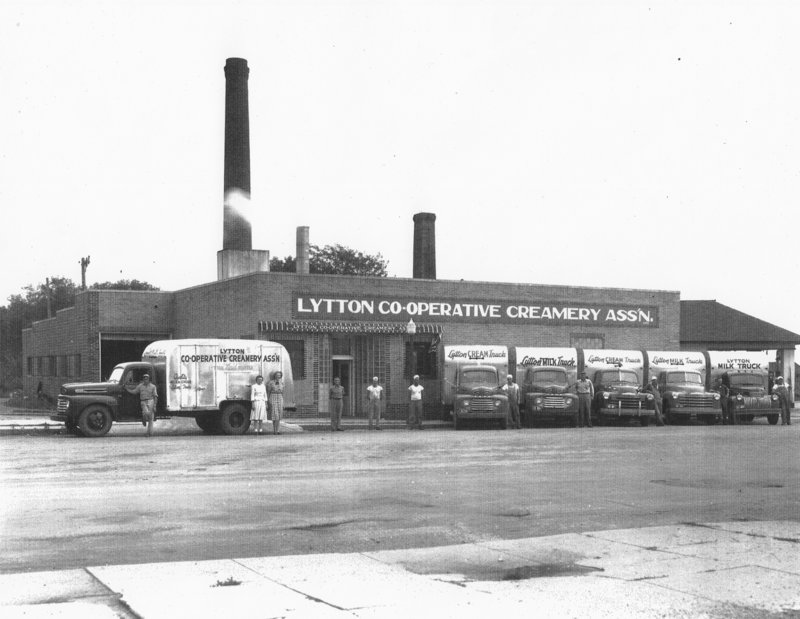
The Lytton Cooperative Creamery Association (featured in my Calhoun County book) was organized in June 1933. Capital for the new venture came from local farmers, who subscribed for shares on a basis of $5 per cow. In 1936, the creamery produced 110,000 pounds of butter. Grade A milk was processed, bottled, and distributed under the name “Lytton Maid” until this was discontinued in 1963. The plant closed in August 1979.
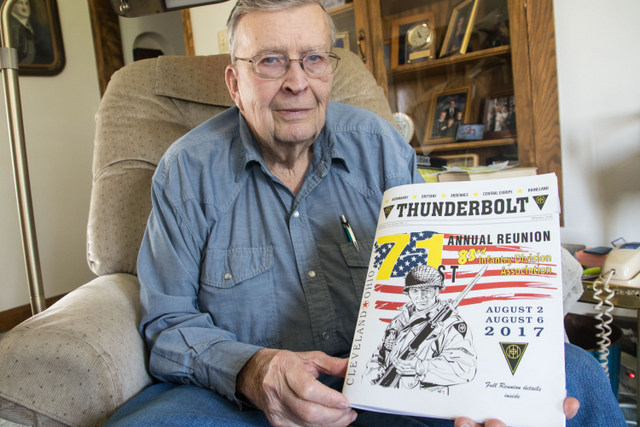
“Thank God It’s Over:” Iowa Veteran Recalls the Final Days of World War 2
While V-E Day (Victory in Europe) was proclaimed “the celebration heard ‘round the world,” it was only a temporary reprieve for Harold Geisinger. This 19-year-old Iowa farm boy from Storm Lake was on his way to Le Havre, France, with the U.S. Army when Germany surrendered unconditionally to the Allies on May 7, 1945.
After a low-key celebration, Geisinger and his fellow soldiers boarded a box car in France bound for Hanover, Germany. Geisinger then joined a convoy in Bavaria, the section of Germany where American troops were guarding railroads, train depots, irrigation sites and more.
While the war was over in Europe, fighting continued on the other side of the globe. In the summer of 1945, there was talk that Geisinger and his fellow soldiers would likely be on board the next U.S. military ship bound for the Pacific Theater. Everything changed, however, when Japan surrendered on Sept. 2, 1945, following President Harry S. Truman’s orders to drop two atomic bombs on Japan in August 1945.
“When we got the word that Japan quit, we didn’t celebrate,” said Geisinger, 91, who still gets tears in his eyes when he thinks back to those days nearly 72 years ago. “We simply sat down and said, ‘Thank God it’s over.’”
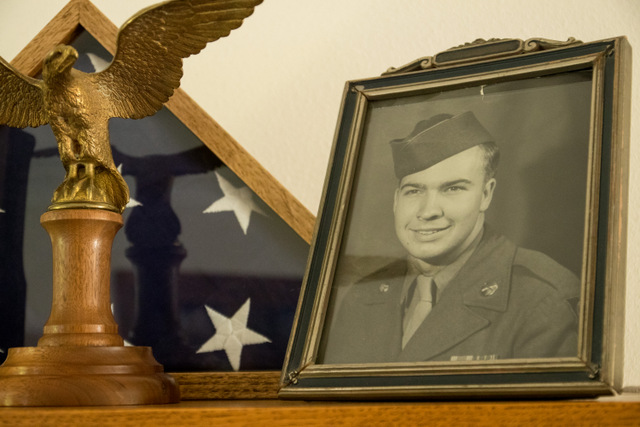
After graduating from Storm Lake High School in 1944, Harold Geisinger was drafted into the U.S. Army on Aug. 2, 1944. “Back then, we all wanted to serve,” he said.
Battle of the Bulge put Geisinger on the fast track
As a World War 2 veteran, Geisinger is becoming a rare breed. Only 620,000 of the 16 million Americans who served in World War II were alive in 2016, according to U.S. Department of Veterans Affairs statistics.
Like many members of the Greatest Generation, Geisinger’s life would never be the same after Japan attacked Pearl Harbor on December 7, 1941. “I was walking up the steps of our house and the radio was on,” said Geisinger, who stills lives in this house on the north edge of Storm Lake. “That’s when I heard the news about Pearl Harbor.”
After graduating from Storm Lake High School in 1944, Geisinger was drafted into the U.S. Army on Aug. 2, 1944. “Back then, we all wanted to serve,” he said.
Following 17 weeks of basic training in Arkansas, things moved quickly for Geisinger. “As my basic training was ending, the Battle of the Bulge was beginning, so the Army fast tracked us,” said Geisinger, who left on Christmas Day 1944 for Camp Myles Standish in Massachusetts. This U.S. Army camp functioned as a departure area for thousands of U.S. soldiers during World War 2.
In mid-December 1944, Germany had launched its last major offensive and intended to split the Allied armies. This surprise blitzkrieg in northwest Europe, which became known as the Battle of the Bulge, did not turn the tide of the war in Adolph Hitler’s favor but did result in American and civilian casualties.
The Battle of the Bulge was still raging when Geisinger shipped out for Europe on January 2, 1945. “I was on my two-week ‘ocean cruise,’” said Geisinger, who had turned 19 just a few days earlier on Christmas Eve.
When Geisinger and his fellow soldiers with the Army’s 83rd Infantry Division, Company I, arrived at Le Havre, France, they were transferred to railroad box cars bound for Givet, a small community in the north of France, near the Belgian border. “These box cars were called ’40 by 8s,’ meaning they could hold 40 men or 8 horses,” said Geisinger, who recalled that it was close to a month after he left America before he had the chance to take a real shower—not just a saltwater shower on the ship.
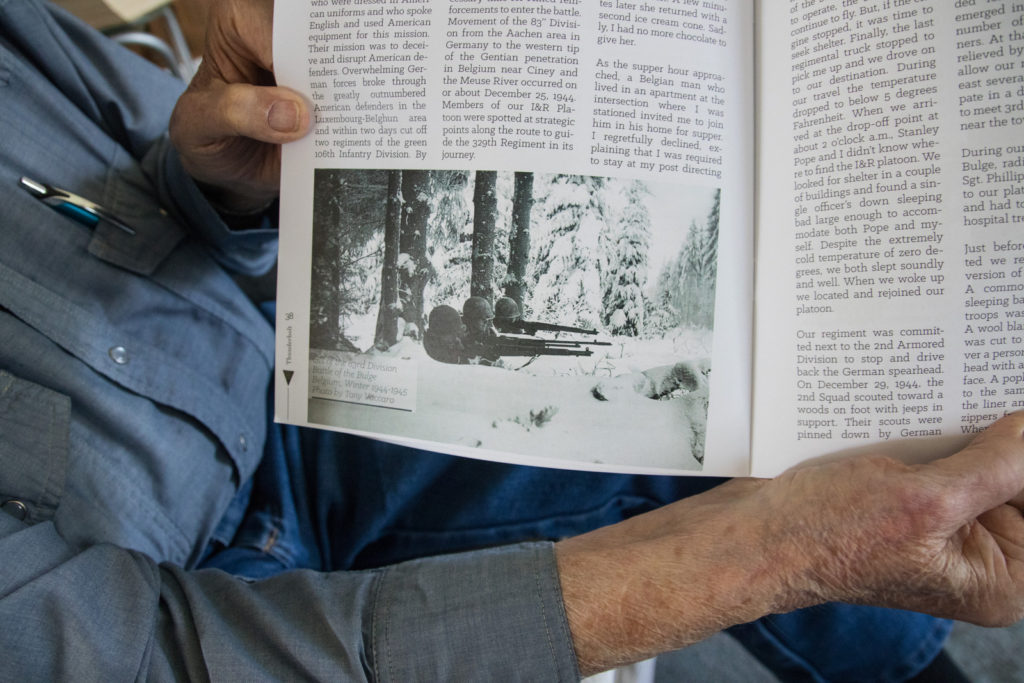
The Battle of the Bulge was still raging when Harold Geisinger shipped out for Europe on January 2, 1945. Geisinger and his division spent most of their time training in the Hürtgen Forest, located along the border between Belgium and Germany. “Our division was preparing to push across Germany,” Geisinger said.
Much worse than the shower situation, however, were the frigid January temperatures and lack of adequate overshoes during the box car ride. “I froze my feet,” Geisinger recalled.
After reaching their destination, Geisinger and his division spent most of their time training in the Hürtgen Forest, located along the border between Belgium and Germany. “Our division was preparing to push across Germany,” Geisinger said.
In the meantime, however, Geisinger was waging his own battle with a cough that wouldn’t go away. The coughing became severe that he couldn’t eat. On Feb. 14, 1945, he had to go on sick call and was diagnosed with viral pneumonia. Geisinger returned to France and was transferred to a hospital in southern England at Newton Abbot. “I was there two months with no medicine,” said Geisinger, who eventually recovered and returned to active duty.
In early May 1945, Geisinger was crossing the English Channel in a ship bound for Le Havre, France, when he heard the news that Germany had surrendered. Although Hitler and the Nazis had been defeated, Geisinger knew he wouldn’t be returning home to northwest Iowa anytime soon. After boarding another box car, Geisinger headed to Bavaria to rejoin Company I and the men he had served with before.
Everyone wondered if they’d be called to fight the war in Japan. “Had we shipped out, some said we would have left from Marseille in southern France and sailed around Cape Horn and onto Japan,” Geisinger said. “When I heard that Japan surrendered, I kept thinking, ‘Someday we’ll get to go home.’”
Transitioning from solider to farmer
That day wouldn’t come for months, however. Geisinger remained in Europe and remembers pulling guard duty along the Danube River. He crossed the river with a buddy one night to meet Russian soldiers on the other side.
“We drank a little beer with a Russian sergeant and tried to communicate using hand signals and the little bit of German we and the Russian had picked up,” Geisinger said. “The one thing the Russian sergeant wanted was American uniforms. He wanted all the American uniforms he could get.”
Geisinger couldn’t access any uniforms other than the one he was wearing. He had no idea why the sergeant wanted American uniforms, although he later suspected an ulterior motive. “I assumed it was for infiltration,” said Geisinger, whose distrust of the Russian sergeant proved accurate as the Cold War heated up.
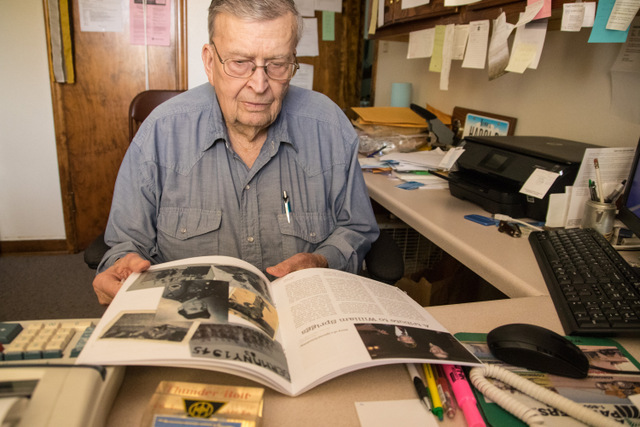
As he sits in his home office, Harold Geisinger looks through pieces of the past, including World War 2 history books.
By the time Geisinger was honorably discharged from the Army, he had achieved the rank of corporal. He looked forward to returning to Storm Lake to farm and finally reached home in July 1946. By then, agriculture had entered a new era as the transition to mechanical horsepower from traditional horsepower became complete. New equipment like combines also became more common in row-crop production.
Geisinger started farming with his father, L.J. Geisinger, on the Washington Township farm north of Storm Lake that had been in their family since 1915. Geisinger also used the G.I. Bill to earn his pilot’s license and enjoyed flying for many years.
Geisinger and his wife, Laura May, a Storm Lake High School classmate, raised their three children on the farm, along with corn, soybeans, hay, cattle and hogs. Farming still interests Geisinger, who helps run the field cultivator in the spring and helps combine in the fall. “I even planted some beans this spring,” said Geisinger, who is proud of the rich heritage of his family’s Century Farm in Buena Vista County.
For decades, Geisinger served as a rifleman in the color guard unit in Alta (VFW Post 6172). While he has retired from these duties, his memories of World War 2 remain vivid, and he’s proud he was able to serve his country.
“My military experiences gave me more of global view of the world,” Geisinger said. “Even though a lot has changed since World War 2 and America has its deficiencies, I don’t know of a better place to call home.”
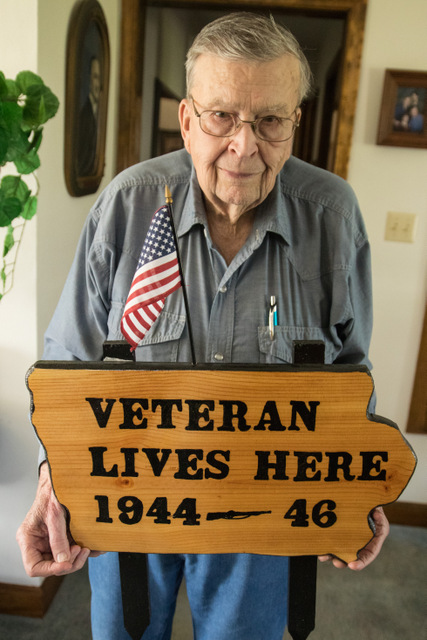
Harold Geisinger’s memories of World War 2 remain vivid, and he’s proud he was able to serve his country.
It was truly an honor to meet Harold Geisinger in May 2017 and interview him at his home and at his family’s farm north of Storm Lake, Iowa. He is a living legacy of America’s Greatest Generation. I’m forever grateful that Harold and hundreds of thousands of others like him were willing to serve. I’m also thankful he was willing to share his stories with me so I can share them with you. (I originally wrote this article for the Memorial Day 2017 of Farm News.)
Want more Iowa culture and history?
I invite you to read more of my blog posts if you want more Iowa stories, history and recipes, as well as tips to make you a better communicator. If you like what you see and want to be notified when I post new stories, be sure to click on the “subscribe to blog updates/newsletter” button at the top of this page. Let’s stay in touch.
Also, if you enjoyed Harold’s military story, be sure to check out my Memorial Day 2017 post on “How to Thank Veterans for Their Service.” I interviewed two recently-retired U.S. Marines from the Wounded Warrior Battalion, and their insights are invaluable.
If you’re hungry for more stories of Iowa history, check out my top-selling “Culinary History of Iowa: Sweet Corn, Pork Tenderloins, Maid-Rites and More” book from The History Press, as well as my Calhoun County” book from Arcadia Publishing, which showcases the history of small-town and rural Iowa. Order your signed copies today! Iowa postcards are available in my online store, too.
P.S. Thanks for joining me. I’m glad you’re here.
@Copyright 2017 Darcy Maulsby & Co.
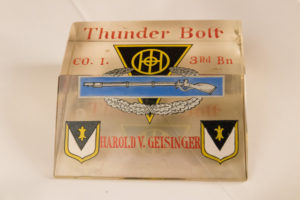
Harold Geisinger served with the U.S. Army’s 83rd Infantry Division, Company I,

Get Your Grill On: How to Build a Better Burger
Love the thrill of the grill? I sure do, especially when I’m crafting a thick, juicy burger I can sink my teeth into. While we talk a lot about burgers during May Beef Month, how much do you really know about this American icon?
The classic hamburger we know and love today is very much an American invention. Stemming from German culinary roots, the burger-on-a-bun phenomenon gained widespread fame at the 1904 St. Louis World’s Fair.
Disaster struck two years later, however, when Upton Sinclair’s novel “The Jungle” (remember the book’s lurid details from high school literature class?) detailed the unsavory side of the American meatpacking industry. Ground beef became a prime suspect, since it could easily be adulterated with questionable additives.
The hamburger might have faded away as a long-forgotten fad were it not for Edgar Ingram and Walter Anderson. When they opened their first White Castle restaurant in Kansas in 1921, White Castle countered the hamburger’s unsavory reputation by becoming bastions of cleanliness, health and hygiene. This paved the way for national hamburger chains founded in the post-World War II boom years, including McDonald’s.
Best burgers, Iowa style
Iowa has made its own distinctive contributions to America’s burger history. Consider the wildly popular Iowa’s Best Burger contest, sponsored by the Iowa Cattlemen’s Association (ICA) and the Iowa Beef Industry Council (IBIC). Iowans submitted more than 9,200 nominations for this year’s contest. Nearly 500 Iowa restaurants were represented in 2017 in the total nominations, setting a new record for the contest.
As a former judge of Iowa’s Best Burger contest, I can tell you how tough it is to pick a winner. Iowans know how to make bodacious burgers, a story I made sure to include in my “Culinary History of Iowa” book.
Size matters when it comes to the Gunderburger at the Irish Shanti, which made the 2017 Top 10 list. The famous Gunderburger started in the late 1970s to put the tiny northeast Iowa community of Gunder on the map. The first Gunderburgers were a smaller version of the one served today. As the Gunderburger started growing in size in the 1990s, its notoriety also grew.
Another 2017 Top 10 Best Burger in Iowa contender is the Ankeny Diner, which offers Maytag Burgers, featuring Iowa’s famous Maytag blue cheese, sautéed onion and Monterey jack cheese. Don’t care for blue cheese? Maybe you’d prefer the Rarebit Burger, served open-faced and topped with spicy Cheddar cheese sauce.
Rarebits were legendary at the iconic Younkers Tea Room in downtown Des Moines for decades. An Iowa-style rarebit burger elevates the traditional Welsh rarebit, which incorporates leftover bits of cheese and the end-of-the-loaf slices of stale bread for a quick supper.
Speaking of Des Moines, the historic East Village is the home of the incomparable Zombie Burger. A previous Top 10 Best Burger in Iowa contender, Zombie Burger serves “gore-met” creations made from the shop’s own custom three-cut beef burger blend. With locations in downtown Des Moines, Ankeny, West Des Moines and the Iowa City area, Zombie Burger is distinguished by classics from the Undead Elvis (a burger paired with peanut butter, fried bananas, bacon, American cheese and mayo) to the Walking Ched (a burger featuring bacon, Cheddar cheese, caramelized onions and mayo on a deep-fried macaroni-and-cheese bun).
Hungry yet?
If all this inspiration has you craving top-quality, Iowa beef, here are my top tips to make your best burgers ever:
• Choose fresh 80/20 ground beef, which provides enough fat to keep your burgers juicy and flavorful.
• Worcestershire sauce adds a whole new depth of flavor to burgers. Add in a healthy dollop and mix it into the meat before forming the patties.
• Use your thumb to create a dimple or well in the center of each patty on the bottom. This helps ensure that the burgers cook evenly. Don’t worry—the indentation will hardly be noticeable by the time the burgers are ready.
• Cook your burgers over medium heat.
• As the patties cook, sprinkle them liberally on both sides with a mixture of salt, fresh-ground pepper, Lawry’s seasoning salt, garlic powder and onion powder.
• Avoid using your spatula to press down on your burgers while cooking. Don’t let all those flavorful juices escape.
• Allow your burgers to rest for a few minutes before serving. This will ensure that the juices redistribute into the meat. Enjoy!
Have any favorite burger recipes or cooking tips? I’d love to hear them. Now go get your grill on!
Hungry for more?
Want more burger inspiration? Check out my blog post on the Lake City Drive-In, where owner Larry Irwin is not only a beef booster, but someone who sees burgers as the perfect palette for culinary creativity with his Burger of the Month flavors. (Don’t miss my recipe for Meatloaf Burgers!)
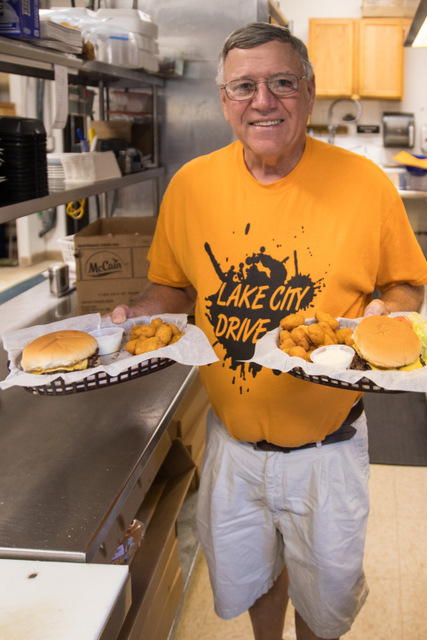
Larry Irwin shows off some tasty burgers from the Lake City Drive-In.
If you’re hungry for more stories of Iowa history, Larry is kind enough to carry my books at the Lake City Drive-In. Not close to Lake City? I invite you to visit my online store, where you can purchase my top-selling “Culinary History of Iowa: Sweet Corn, Pork Tenderloins, Maid-Rites and More” book from The History Press, as well as my “Calhoun County” book from Arcadia Publishing, which showcases the history of small-town and rural Iowa. Order your signed copies today! Iowa postcards are available in my online store, too.
One more thing–check out more of my blog posts if you want more Iowa stories, history and recipes, as well as tips to make you a better communicator. If you like what you see and want to be notified when I post new stories, be sure to click on the “subscribe to blog updates/newsletter” button at the top of this page. Let’s stay in touch!
This originally appeared as one of my weekly columns in Farm News.
P.S. Thanks for joining me. I’m glad you’re here.
@Copyright 2017 Darcy Maulsby & Co.
